
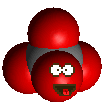 |
Even More Molecules with
Silly or Unusual Names |

Miscellaneous chemical funnies...
This page contains some miscellaneous funny or quirky stories, mostly from chemistry but also from other related sciences.
Silly Molecule Names
- Leon Mathiasen from Arhus University found that in winemaking, lactic acid bacteria is known as LAB...so you can put chemicals into your lab, and put LAB into your chemicals.
- and Matthew Nowak of Penn State Uni reminded me about the molecule NAD, which is a funny acronym for unprotinated form of nicotinadmide adenine dinucleotide. It's used in tons of biological reactions as a proton acceptor or donor. (For those of you who don't get the joke, NAD is English slang for testicle).
- Lily Zhou told me about 2 buffers called MOPS (3-(N-morpholino)propanesulfonic acid) and PIPES (piperazine-N,N'-bis-[2-ethanesulfonic acid]), which are presumably used in cleaning...
- Brooke Richardson tells me of another called CHAPS (3-[(3-Cholamidopropyl)dimethylammonio]-1-propanesulfonate)... I assume these are the CHAPS that use the MOPS to clean the PIPES...
- J.J. Keating tells me of yet another called DIM (diindolylmethane) which is a naturally occurring compound found in vegetables such as broccoli, cauliflower and cabbage.
- Arjen van Doorn told me of a gene called called the RING gene, which stands for Really Interesting New Gene.
- On a similar theme, compounds that appear as 'frequent hitters' in many biochemical high throughput screens and which obscure the smaller signals from required trace components are often referred to as being 'promiscuous compounds'. They also go by the acronym PAINS, meaning Pan Assay Interference Compounds. [Thanks to Jan Linders for these links.]
- Within the field of fragrance chemicals there are many strange names, although most of them tradenames. One example told to me by Bo Jensen is 'Montaverdi' for 3(Z)-hexenyl-cyclopropylcarboxylate, marketed by International Flavors and Fragrances. The explanation is that this ester has a fresh, green odor, and that the market abounds with green-smelling chemicals, each with a 'green' tradename. So how to give it a novel green-sounding name? Although Monteverdi was a composer, his name also means 'green mountain'. Voila!
- Jan Linders told me of an article about a Korean chemical company who are about to market a new drug called Zydena to treat erectile dysfunction. The company's name is Dong-A! You wouldn’t expect that this company would develop anything else...
- Richard Irwin says that an ingredient in many of performance enhancing drinks could be called smartallic or i-nos-it-ol.
- And Ken Ruiz emailed me to say that he always found it difficult to tell his wife, Lynne, of his feelings towards her, without thinking he'd had come across a new member of the Penicillin family: I-luv-u-lin.
- And on the subject of fictitious names for molecules, Tim Rickard tells me that the fanciful name for the molecule shown on the left, below, is 'doggycene', while David Schmidt tells me that the molecule in the middle should be called 'kermitinol' or 'peroxykermit' after Kermit the Frog. John Perkins told me that when he walked into the lab at Stanford one morning, the Dewar benzene derivative, labelled 'musicstandadiene' (below, right) was written on the whiteboard. He still doesn't know whether anyone has ever made it!

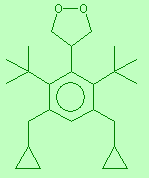

- And Robert Grossman said that one definition of the molecule undecane is that it wasn't decane. He also says that a group that binds to a metal through one atom is called monodentate (one tooth, because it bites once). If it binds through two atoms, it is bidentate, three = tridentate, etc. If it binds through ten atoms, it is decadentate, which makes it a really decadent molecule.
- Dr John Moody from the University of Plymouth, told me that nitric oxide donors are called NONOates of which a good example is spermine NONOate. And he also told me about some nonionic detergents which go by the names of Triton X-100, Lubrol PX, Tween 80 and Brij 35.
- Malcolm Farmer suggested that linoleic acid might be an unsaturated fatty acid extracted from old floor coverings. Actually, this isn't so far fetched, since linoleum is made from linseed oil and finely ground cork, you probably could extract linoleic acid from it.
He also said that as an example of the odd organisms that people screen for when looking for new antibiotics (e.g. Streptomyces for streptomycin, Ascomycetes for ascomycin, etc), we have the antibiotic compound rapamycin. It isn't, unfortunately, derived from the ground up practitioners of a particularly annoying musical genre, but from a soil fungus first discovered on Easter Island (Rapa Nui).
- Ian Livingstone told me about the soapy molecule called saponin, which he remembered from his school days, together with the question "what's saponin"?
- Andy Mance used to work with a dye called Fat Brown B, which sounds like the name of a jazz singer. It is also called by its less jazzy name of Solvent Red 3, and Kay Dekker sent me its structure: C18H16N2O2.
- Andy Wigginton from the University of Kentucky says that they sometimes deal with a group of pollutants that can be released from underground gasoline storage tanks. These include Benzene, Toluene, Ethylbenzene, and Xylene, which they abbreviate as B-TEX, which sounds like an invocation to become a cowboy. When they are just concerned with the last three pollutants, they are simply TEX (somehow it seems appropriate that a gasoline-derived group of pollutants should be so associated with home of the US ex-President).
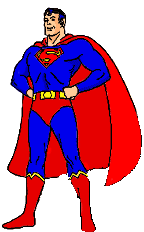 Lars Finsen tells me that the octafluoroxenates with the anion XeF82- are the most stable noble gas compounds known. But if any analogous krypton compounds were ever made, they would probably be called fluorokryptonates in the higher oxydation stages and fluorokryptonites in the lower oxidation stages, in accordance with traditional nomenclature - for instance, sodium tetrafluorokryptonite, Na2KrF4. He says that this might possibly be a useful substance to have around if you were planning to rob a bank in Metropolis? Tue Bruun Petersen, however, thinks that the name kryptonite would have been given to the anion KrO22- before IUPAC nomenclature was enforced.
Lars Finsen tells me that the octafluoroxenates with the anion XeF82- are the most stable noble gas compounds known. But if any analogous krypton compounds were ever made, they would probably be called fluorokryptonates in the higher oxydation stages and fluorokryptonites in the lower oxidation stages, in accordance with traditional nomenclature - for instance, sodium tetrafluorokryptonite, Na2KrF4. He says that this might possibly be a useful substance to have around if you were planning to rob a bank in Metropolis? Tue Bruun Petersen, however, thinks that the name kryptonite would have been given to the anion KrO22- before IUPAC nomenclature was enforced.
- Charles Osborne tells me that Monsanto produced the early Light Emitting Diodes back in the sixties from gallium arsenide - GaAs. Apparently they couldn't resist calling their products: GaAs Lites!
- Wayne Povey from Keele University said that one molecule name that makes him chuckle is methylisobutyl ketone abbreviated to MIBK, which always makes him think of Men in Black: Agent K, played by Tommy Lee Jones.
- Neil Brookes emailed me to say that in the 1970's there was a filtration-aid called Dicalite (which gave rise to 'She was only the chemist's daughter, but she set your....', etc).
 John Wolstenholme emailed me to say that he remembered a Professor at Oxford who once synthesised a Mo compound containing some olefinic and amine ligands, and (unsuccessfully) tried to get it named 'ene amine amyne a Mo'. And similarly, Matt Jandreau told me that one of his professors mentioned a new molecule (structure, right) in organic chemistry. He said "Old McDonald made this molecule... ene-yne-ene-yne-one".
John Wolstenholme emailed me to say that he remembered a Professor at Oxford who once synthesised a Mo compound containing some olefinic and amine ligands, and (unsuccessfully) tried to get it named 'ene amine amyne a Mo'. And similarly, Matt Jandreau told me that one of his professors mentioned a new molecule (structure, right) in organic chemistry. He said "Old McDonald made this molecule... ene-yne-ene-yne-one".
- John Wright told me that in the 1960s there was a report of Kryptic acid (Science 142 242, 1964), but no-one ever managed to repeat the work, and it is now treated as an error.
- Gary Randall emailed me to suggest Oleic acid , and said that it was often called Bullfighter's Acid. Geddit?
- Joe Davidson from the University of Michigan came up with the following common abbreviations for molecules: TEA (Triethylamine, an organic Bronsted base), TIPS (Tri-isopropylsilane, a protecting group for alcohols), MOM (Methoxymethane, or methoxymethyl, an ether that also protects alcohols), and COD (1,4-cyclo-octadiene, a common ligand for many transition metals, that ironically has a potent odour of fish). Kevin Anderson also suggested that mercaptoundecanol can be abbreviated as MUD. Must be a messy synthesis...

 HI-O Silver is a wonderful inorganic compound suggested by Michael Klemmer, although it doesn't actually exist. If it did, it would surely be the Lone Ranger's favourite molecule. For those of you who don't remember this classic TV series, the Lone Ranger rode a horse called Silver, and his catch phrase was "Hi-O-Silver...away!" I haven't yet found a molecule called Tonto, though... This originally appeared as graffiti on a bathroom stall in the Chemistry building at the University of Minnesota as the reaction:
HI-O Silver is a wonderful inorganic compound suggested by Michael Klemmer, although it doesn't actually exist. If it did, it would surely be the Lone Ranger's favourite molecule. For those of you who don't remember this classic TV series, the Lone Ranger rode a horse called Silver, and his catch phrase was "Hi-O-Silver...away!" I haven't yet found a molecule called Tonto, though... This originally appeared as graffiti on a bathroom stall in the Chemistry building at the University of Minnesota as the reaction:
AgO + HI  HIO + Ag [Up arrow] (Away!)
HIO + Ag [Up arrow] (Away!)
[Thanks to John H. Havener, Jr for the formula, and to Bob Buntrock for the equation.]
- Carl Kemnitz and Michael A. Bailey both told me that barbituric acid was named by its discoverer, Baeyer, after a girl named Barbara with whom he was enamoured. There are two additional "Barbara" molecules that are of interest: barbaralane and barbaralone. But barbaralane is not named after the street on which Barbara lived. The barbaralone is a bit more depressing whether you interepret it as barbara-alone or barber alone (bad business).
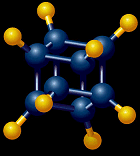 Bert Ramsay tells me that he developed a hypothetic molecule called E-cubane, named after the artist MC Escher, who was renown for his 3D pictures of 'impossible' structures and buildings'. E-cubane is an 'impossible' version of cubane, as you can see from the image right.
Bert Ramsay tells me that he developed a hypothetic molecule called E-cubane, named after the artist MC Escher, who was renown for his 3D pictures of 'impossible' structures and buildings'. E-cubane is an 'impossible' version of cubane, as you can see from the image right.
- Adam Hill told me about fictitious molecules called 'propyl people ethers' after the novelty song, "Purple People Eaters" written and performed by Sheb Wooley (1921-2003), that reached #1 in the US pop charts in 1958.
- Jan Linders sent me a reference to a paper in ACS Chem. Med Lett. which goes on about 'centamolecules'. Apparently, these are just molecules with molecular weights in the hundreds, although it seems a rather pointless name to me. By the same reasoning, molecules with molecular weights in the thousands should be called 'kilomolecules', as in'Attack of the KiloMolecules"...
- Charles Turner sent me an article which describes how sodium citrate can turn crumbly cheese into the smooth, creamy cheese sauce used on American nachos. Coincidentally, the chemical formaula for sodium citrate is Na3C6H5O7.
- Christopher C. Wells, Anne Gorden, Jan Linders and Vincent Schüler have sent me a huge list of molecules named after places...
himalayamine
Himalaya mountains | borneol
Borneo | pakistanamine
Pakistan | americanin
America | ecuadorin
Ecuador | grenadadiene
Granada | virginiamycin
Virgin islands |
mauritiamine
Mauritius | alaskene & alaskaphyrin
Alaska | texaphyrin
Texas | taiwanins
Taiwan | montanastatin
Montana | mediterranenols
Mediterranean | bahamamide
The Bahamas |
arizonins
Arizona | pacifenol
The Pacific Ocean | brazilin
Brazil | argentinine
Argentinia | guyanin
Guyana | jamaicin
Jamaica | louisianins
Louisiana |
floridanolide
Florida | oregonenes
Oregon | utahin
Utah | michigazone
Michigan | ukrain
Ukraine | malaysic acid
Malaysia | thailandine
Thailand |
mongolicains
Mongolia | vanuatine
Vanuatu | australinols
Australia | tasmanine
Tasmania | vietnamine
Vietnam | angolamycin
England | gabonine
Gabon |
senegalene
Senegal | madagascarin
Madagasgar | tanzanene
Tanzania | ugandoside
Uganda | yemenimycin
Yemen | syriamycin
Syria | jordanine
Jordan |
atlantone
The Atlantic Ocean | mexicanolide
Mexico | panamine
Panama | albanols
Albania | srilankenyne
Sri Lanka | seychellogenine
The Seychelles | providencin
Providencia (Old Providence Island) |
quebecol
Quebec | | | | | | |
But there doesn't appear to be a molecule named after Britain...?
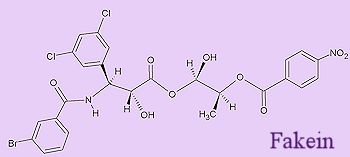 Fakein is the name given to a fictitious molecule dreamt up by Angelo Gavezzotti from the University of Milan. He devised a new molecule based on a structure similar to that of taxol, and then used standard off-the-shelf free software and a simple laptop to predict all the structural, thermodynamic and crystallographic properties of the imaginary molecule. He even devised plausible experimental routes to extract the molecule from a nautural source, the imaginary bush Artemisia fictitia that grows spontaneously in the tropical region of the State of Erewhon. Erewhon (an anagram of Nowhere) is the name of the non-existent country in the 1872 satirical novel of the same name by Samuel Butler. Gavezzotti gave fakin a catalogue number of M31NGC224, which mimics the labels usually given to pharmaceutical leads, but is actually the catalog number of the Andromeda Galaxy. And fakein was said to be in the development pipeline at the NEMOpharma Company, another figment of the author’s imagination! The reason for all this subterfuge was to demonstrate how easy it is nowadays to realistically fake the extraction and characterisation of a 'new' molecule. The characterisation, data, spectra and properties of the fake molecule are so realistic and believeable that they could pass peer review in many Journals. The title of the paper 'Crystallography without Crystals' is really a warning about the future of scientific credibility now that molecular 'deep fakes' are possible.
Fakein is the name given to a fictitious molecule dreamt up by Angelo Gavezzotti from the University of Milan. He devised a new molecule based on a structure similar to that of taxol, and then used standard off-the-shelf free software and a simple laptop to predict all the structural, thermodynamic and crystallographic properties of the imaginary molecule. He even devised plausible experimental routes to extract the molecule from a nautural source, the imaginary bush Artemisia fictitia that grows spontaneously in the tropical region of the State of Erewhon. Erewhon (an anagram of Nowhere) is the name of the non-existent country in the 1872 satirical novel of the same name by Samuel Butler. Gavezzotti gave fakin a catalogue number of M31NGC224, which mimics the labels usually given to pharmaceutical leads, but is actually the catalog number of the Andromeda Galaxy. And fakein was said to be in the development pipeline at the NEMOpharma Company, another figment of the author’s imagination! The reason for all this subterfuge was to demonstrate how easy it is nowadays to realistically fake the extraction and characterisation of a 'new' molecule. The characterisation, data, spectra and properties of the fake molecule are so realistic and believeable that they could pass peer review in many Journals. The title of the paper 'Crystallography without Crystals' is really a warning about the future of scientific credibility now that molecular 'deep fakes' are possible.
Ref: Angelo Gavezzotti, Crystallography without Crystals: A Structural Study of Fakein,
Helv. Chim. Acta 2022, 105, e20220005. Thanks to Jan Linders for spotting this one.
And here's another another fake molecule sent to me by Charles Turner, which appeared in the spoof Journal of Immaterial Science
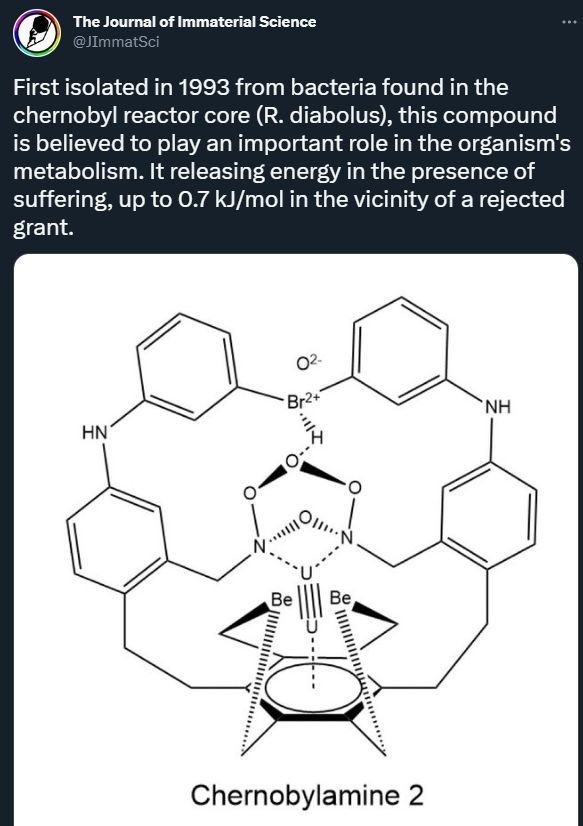
Funny Titles and Authors for Scientific Papers
- And here's one for physicists. When, a year or so ago, physicists at CERN thought (incorrectly as it turns out) they'd discovered neurinos that travelled faster than light it generated a lot of speculation. An excellent example (below) comes from the University of Bristol, who produced a paper with possibly the best abstract ever. There are examples elsewhere of ridiculously short abstracts and even entire papers in other disciplines. [Thanks to Charles Turner for these]
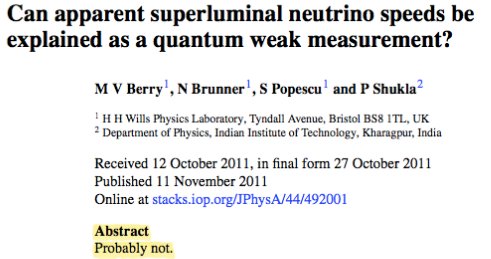
The title is fine, but is that the abstract?
- And here's another lesson, courtesy of Charles Turner again: Proof-read your manuscript draft carefully before you submit it to a Journal, or mistakes like that shown below can occur. In this case, the referees and the Editor missed the fact that a co-author had inserted a rude comment about someone else's paper into the text, and it was published as is! The mistake was eventually spotted, and the paper was corrected a few weeks later. Needless to say, the author of the 'crappy' paper, Caitlin Gabor, was not amused!
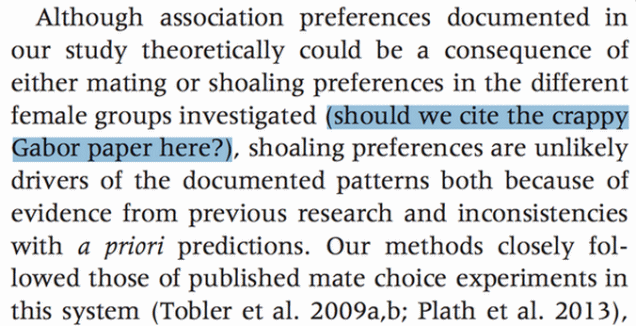
- There is a paper in (Optics and Photonics News 1 (1990) 44) entitled 'Observation of the 0-fs pulse', by authors who were chosen because of their names, Knox, Knox, Hoose, Zare. [Knock, Knock, who's there?]
- Jan Linders sent me a paper with the ridiculous title of: From Dipyrrolonaphthyridinediones to Quinazolinoindolizinoindolizinoquinazolines [J. Org. Chem. DOI: 10.1021/acs.joc.9b00839]. Who says chemistry is difficult!
- Charles Turner told me about a scientific paper with a ludicrously long title, recently published in JACS (DOI: 10.1021/ja4092775), which goes: "[Cp2TiCH2CHMe(SiMe3)]+, an Alkyl–Titanium Complex Which (a) Exists in Equilibrium between a β-Agostic and a Lower Energy γ-Agostic Isomer and (b) Undergoes Hydrogen Atom Exchange between α-, β-, and γ-Sites via a Combination of Conventional β-Hydrogen Elimination–Reinsertion and a Nonconventional CH Bond Activation Process Which Involves Proton Tunnelling". After reading the title, there's no real point reading the paper, we already know the content!
- Dom Palubiski told me about a paper in ACS Nano with the superb title of 'Will Any Crap We Put into Graphene Increase Its Electrocatalytic Effect?'. The authors were trying to make the point that almost any element that you add to graphene seemed to improve its electrocatalytic performance, and so there are hundreds or thousands of nearly identical papers all saying 'we added x to graphehe and made a better catalyst' - and because x can be almost anything, nearly all of these papers are a waste of time. The authors made their point clearer by doping graphine with guano (bird poo) which is rich in elements such as N, P, etc, and it was no surprise when they found that this, too, improved the graphene properties! So the title of their paper isn't quite as flippant as first thought - the authors had literally added crap into graphene to improve its performance.
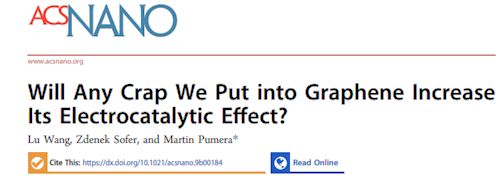
- Jenny Allcock told me that her biology textbook was called "Living Things" and was written by the appropriately named author V. Slaughter.
- And Simon Cotton told me about the paper "Studies on Popcorn Aroma and Flavor Volatiles", published in the Journal of Agricultural and Food Chemistry, (1997) 45 837-843, whose lead author is Ron G. Buttery!
- On the subject of authors, Rob Towart emailed me to say that he'd discovered a large number of papers by the two Phil brothers, D. Phil and M. Phil. They have been very active for at least 50 years, in very diverse areas.....D. Phil from the 50's, with interests from cirrhosis to scuba diving, and the younger M. Phil from the 80's with interests from cleft lip to retinitis pigmentosa... So, either Phil is a very common surname for scientists, or the Journals have been mistaking the qualification suffix, M.Phil and D.Phil, for another author's name. Maybe we'll start seeing papers 'authored' by the famous chemists M.Chem and M.Sci soon, as well.
- Rob also told me of another unusual scientific family, with the surname of Jr. The large Jr family have some 30 publications, according to PubMed, although each seems to be a different author: S.R. Jr, G.M. Jr, R.L. Jr, etc. There is even one poor member of this (extended?) family who has no first name, but has published on redox indicators with the more conventionally-named B.D. Jones and J.D. Ingle. Again, their work extends over 40 years, and covers everything from physical chemistry to cardiovascular effects in the rainbow trout. I'm guessing again that this is a typo by the Journal, who have mistaken the suffix 'Jr' meaning 'Junior' as the full surname, so instead of say, "Paul May, Jr" being cited as "P. May, Jr.", it's become "P.M. Jr."
On the same theme, Bob Bagnall recalled that medical papers always insist on adding the authors' qualifications, and that gradually a fictitious author called B.Chir began to appear in the medical literature, thanks, no doubt, to an error at the printers. He/she had no qualifications, of course, since he/she was actually someone else's qualifications. But amazingly the 'author' gradually acquired qualifications of their own, which was probably due to over-enthusiasm by a Journal editor who couldn't track down the actual qualifications and decided to add some general medical ones. After that, presumably the qualifications stuck.
- Bob also said that there are articles by multiple authors that include someone called Ibid, or sometime I.bid. And he remembers seeing an article by a Russian where the author submitted the article with a line after the abstract that in Russian read something like 'submitted XXXX' where XXXX was the date of submission. The editor mistook this for a name and date, and the word 'submitted' in Russian became an author of the paper!
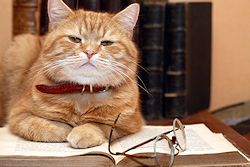 And Charles Turner pointed me to an article about F.D.C. Willard, who was the co-author of a number of scientific papers in the 1970s. It turns out that Willard is actually a cat. The story goes that Professor Jack H. Hetherington, asked a colleague at Michigan State University to read over a paper he’d written on the subject of low temperature physics and planned for submission to Physical Review Letters. After reading over the paper, the colleague told Hetherington that he had often referred to himself using the words “we” and “our”. Normally this isn't a problem for most Journals. But PRL had a rule that stated papers with a singular author shouldn’t use the first person plural. Being the 1970s, Hetherington had typed up the entire paper using a typewriter, so fixing this mistake would have involved retyping the entire manuscript. Instead, he simply invented a co-author, his cat, Chester. To give the cat a little more credibility, Hetherington stylised Chester’s name as “Felis Domesticus Chester, sired by Willard” which was shortened to “F.D.C. Willard”. The paper was published successfully later that year.
And Charles Turner pointed me to an article about F.D.C. Willard, who was the co-author of a number of scientific papers in the 1970s. It turns out that Willard is actually a cat. The story goes that Professor Jack H. Hetherington, asked a colleague at Michigan State University to read over a paper he’d written on the subject of low temperature physics and planned for submission to Physical Review Letters. After reading over the paper, the colleague told Hetherington that he had often referred to himself using the words “we” and “our”. Normally this isn't a problem for most Journals. But PRL had a rule that stated papers with a singular author shouldn’t use the first person plural. Being the 1970s, Hetherington had typed up the entire paper using a typewriter, so fixing this mistake would have involved retyping the entire manuscript. Instead, he simply invented a co-author, his cat, Chester. To give the cat a little more credibility, Hetherington stylised Chester’s name as “Felis Domesticus Chester, sired by Willard” which was shortened to “F.D.C. Willard”. The paper was published successfully later that year.
- Carl Kemnitz also tells me that conceptually, the strangest Journal article title that he's come across was "Stiff and Sticky in the Right Places: The Dramatic Influence of Preorganizing Guest Binding Sites on the Hydrogen Bond-Directed Assembly of Rotaxanes." Rotaxanes, by their very nature are pure innuendo since they are rod-like molecules that are thrust through the hole of a cyclic structure (imagine demonstrating the concept by placing your index finger of one hand through the hole in the other hand made by the "OK" symbol). What makes things better is that one of the authors' names was Teat and another Wong. How this made it past the editors of JACS, I don't know. The reference is: J. Am. Chem. Soc. 123 (2001) 5983.
- And on the subject of curiously named authors for papers, I can cite one of my own papers about the Chemistry of Space Dust, whose authors were: D.R. Flower, G. Pineau des Forêts, D. Field and P.W. May, Mon. Not. R. Astron. Soc. 280 (1996) 447, i.e. the very Spring-like: Field, Forest, Flower and May!

- Continuing the theme, Sikke M. Kingma from Leiden University told me: "I was reminded of a paper known in 'my' field (theoretical chemistry/chemical physics) containing tables with detailed numbers describing "Bounds to Two- and Three-Body Long-Range Interaction Coefficients for S-State Atoms" (J. Chem. Phys., 83, (1985) 3002 ), with authors called (J.M.) Standard and (P.R.) Certain."
- Another classic, sent to me by Jan Linders, concerns strained molecules, with the superb title "Foregoing Rigidity to Achieve Greater Intimacy" (A. Filatov, et al, Angew. Chemie Int. Ed, 48 (2009) 8473.
- Another superbly titled paper, sent to me by Charles Turner, is: Self-inflicted testicular amputation in first lysergic acid diethylamide use [J. Addict Med. (2013) 7 83-4]. That's what I call a really bad trip!
- And still on the same theme, Daniel Shane from Cambridge University tell me that George Gamow and his student Ralph Alpher once wrote a famous cosmogenesis paper, and Gamow put Hans Bethe's name on it as well, just so it would be by Alpher, Bethe and Gamow (alpha, beta and gamma). It is further alleged that Gamow tried to persuade another scientist (R.C. Herman) to change his name to Delter, and come in as a fourth author, to add to the joke. I believe the paper was published in the Physical Review on April 1, 1948.
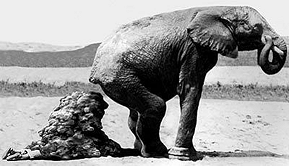 Charles Turner told me of a biological paper which has managed to get the phrase 'Shit happens' into the title of a respected scientific Journal! The paper concerns the various creatures (dung beetles, amphibians, etc) that can live in elephant droppings, and is actually entitled: "Shit Happens (to be Useful)! Use of Elephant Dung as Habitat by Amphibians", A. Campos-Arceiz, Biotropica 41 (2009) 406.
Charles Turner told me of a biological paper which has managed to get the phrase 'Shit happens' into the title of a respected scientific Journal! The paper concerns the various creatures (dung beetles, amphibians, etc) that can live in elephant droppings, and is actually entitled: "Shit Happens (to be Useful)! Use of Elephant Dung as Habitat by Amphibians", A. Campos-Arceiz, Biotropica 41 (2009) 406.
- Charles also tells me of some other funny titles for scientific articles: "New Dust Belts of Uranus: One Ring, Two Ring, Red Ring, Blue Ring", and "How to Think, Say, or Do Precisely the Worst Thing for Any Occasion" which both appeared in Science, and "Fellatio in Captive Brown Bears: Evidence of Long‐Term Effects of Suckling Deprivation?", A Sergeil et al, Zoo Biol. (2014) doi: 10.1002/zoo.21137. His favourite, though is "Crabs and Barnacles of the Texas Panhandle"; the joke being that the Texas panhandle is a desert, so you're about as likely to find crabs and barnacles there as you are to find a polar bear in the African jungle. Some other classics include: "Fellatio by fruit bats prolongs copulation time" Tan M, et al., PLoS One, 4 (2009), e7595; "Implosion of living Nautilus under increased pressure", Y. Kanie, et al., Paleobiology 6 (1980) 44; "The first case of homosexual necrophilia in the mallard", C.W. (Kees) Moeliker, DEINSEA 8 (2001) 243. Another excellent paper title is: "Penetration of the Oral Mucosa by Parasite-Like Sperm Bags of Squid: A Case Report in a Korean Woman", which appeared in the J. Parisitology in 2012.
- Charles Turner also pointed me to two artciles discussing the silly or inappropriate titles for scientific papers: one from the online science magazine slate.com and the other from IFL Science. These include gems such as: “Are full or empty beer bottles sturdier and does their fracture-threshold suffice to break the human skull?”, “Sauropod farts warmed the planet”, “Teeth in the brain: An unusual presentation of penetrating head injury”, "From Urethra With Shove: Bladder Foreign Bodies. A Case Report and Review", "Carbon Monoxide: To Boldly Go Where NO Has Gone Before", "Head and Neck Injury Risks in Heavy Metal: Head Bangers Stuck Between Rock and a Hard Bass", "Practice Makes Perfect: Rectal Foreign Bodies", and "Chemical Processes in the Deep Interior of Uranus".
- And yet more on the same theme, there are 4 papers by an American/Italian group who, for a joke, added a fictitious author by the name of Stronzo Bestiale, which means 'complete arsehole'. The refs are: Hoover W.G., Posch H.A., Bestiale S., J. Chem Phys. 87 (1987) 6665; Moran B., Hoover W.G., Bestiale S., J. Stat. Phys. 8 (1987) 709; W.G. Hoover, H.A. Posch, B.L. Holian and S. Bestiale, Bull. Am. Phys. Soc. 32,(1987) 824; and W.G. Hoover, B. Moran, B. Holian, H. Posch and S. Bestiale, Bull. Am. Phys. Soc. 32, (1987) 1370. Stronzo Bestiale is allegedly affiliated to the Institute of Experimental Physics, University of Vienna, and he even has a Scopus profile. It apparently came about because Hoover had a paper rejected from PRL, and he had to modify it to satisfy the referees. A few days later on a flight to Paris, next to him were two Italian women who spoke among themselves, saying continually: “Che stronzo (What an asshole)!”, “Stronzo bestiale (Total asshole)”. Those phrases stuck in Hoover's mind, and when they were translated for him he thought that 'Stronzo Bestiale' would have been the perfect co-author for a refused publication. So he submitted the papers again, simply by changing the title and adding the name of that author. And they were published. [Thanks to Fabio Pichierri and David Richerby for some of this info. See also here.].
 And yet more on the same theme, there are a number of papers in journals by authors named Yin and Yang. A chemistry related one is: Yin C. and Yang C.Z. J. Appl. Polymer Sci, 82 (2001) 263.
And yet more on the same theme, there are a number of papers in journals by authors named Yin and Yang. A chemistry related one is: Yin C. and Yang C.Z. J. Appl. Polymer Sci, 82 (2001) 263.
- In the Journal called Physical Chemistry Chemical Physics, which is often abbreviated as PCCP, there was a paper published entitled "PCCP does exist" about the P-C-C-P molecule. [PCCP, 2(10), 2000, 2245.]
- And then there is this rather dubious title: "Phosphorus doping of diamond-like carbon films by radio frequency CVD-cum-evaporation technique" [R. Dey, et al., Diamond Relat. Mater. 82 (2018) 70.] I don't like to dwell on what a 'cum-evaporation technique' might entail...
- The Journal Angewandte Chemie International Edition has for several years been including various silly puns, jokes, and references to popular culture in the by-lines for their articles. A number of these have been listed in the website Carbon-based Curiosities and in Derek Lowe's blog, but I've included some here. The one below is obviously a pun relating to the well-known computer game...
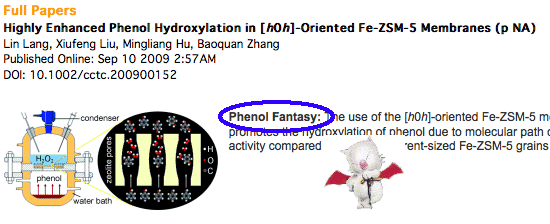
- ...and there are others referring to Star Trek, Marvel Comics, Terminator and the X-files, as well as music references, such as Mike Oldfield, Ace of Base, Tina Turner, Jimi Hendrix, Offspring, My Sharona, Le Freak, System addict, the Sex Pistols, old classics like Roll out the Barrel, On Top of Old Smokey and 'Yes, we have no bananas', the American Automobile Association, the London Tube, and just generally groan-inspiring puns: [1], [2], [3] and [4]. If anyone has any more, I'll be happy to add them to the list...
 There's a paper in Chem. Rev. with the title The Hitchhiker's Guide to Flow Chemistry, with a superb graphical abstract with the words 'DON'T PANIC' written on it in large red comforting letters.
There's a paper in Chem. Rev. with the title The Hitchhiker's Guide to Flow Chemistry, with a superb graphical abstract with the words 'DON'T PANIC' written on it in large red comforting letters.
- or how about Fantastic Yeasts and where to find them: the hidden diversity of dimorphic fungal pathogens published in Curr. Opin. in Microbiol. 52 (2019) 55?
- Some others are: Size Matters, If You Control Your Junk, CEPR Discussion Paper No. DP12648
- or Nudge-nuge, WNK-WNK (kinases), say no more? published in New Phytologist (2018)
- Insane in the membrane, insane in the brain!, published in Thrombosis Res. 152 (2017) 96.
- Snakes on a Spaceship - An Overview of Python in Heliophysics, J. Geophys. Res: Space. Phys., 123 (2018)
- Would Bohr be born if Bohm were born before Born?, Am. J. Phys. 76 2008 143.
- Conan the Bacterium, Patrick Huyghe, Sciences 38 (1998) 4
- Carbon monoxide: to boldly go where NO has gone before, Sci. STKE 230 (2004) RE6
- Fifty ways to Love your Lever: Myosin Motors, S.M. Block, Cell 87 (1996) 151.
- PGAMgnam Style: A Glycolytic Switch controls Biosynthesis, Cancer Cell 22 (2012) 565
- and finally Rodinia descendants in South America, Precambrian Res., (2008) by Reinhardt A. Fuck, et al.
- Charles Turner told me about a scientific paper which has the highest number of co-authors ever reported. The article in Physical Review Letters [G. Aad, et al. Phys. Rev. Lett. 114, 191803 (2015)] is the first joint paper from the two teams that operate the two massive detectors at the Large Hadron Collider (LHC) at CERN. The paper has a whopping 5,154 authors; only the first 9 pages in the 33-page article describe the research itself (including references). The other 24 pages simply list all the authors and their institutions.
- Many more silly or quirky paper titles from other fields of science can be found at: https://twitter.com/lisafstinson/status/1148487441495388160
- This one is not a silly book/paper title, but probably the best introduction to a scientific book ever written. It's from: States of Matter by David L. Goodstein (Dover, 2002).
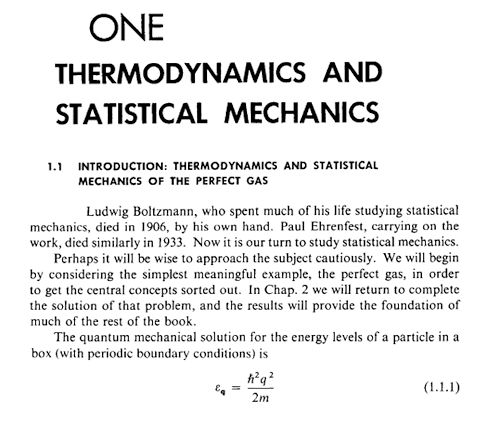
- David Fairley alerted me to this chemical oddity. In the 1971 issue of J. Org. Chem. a paper was written in iambic pentameter - the poetic style often used by Shakespeare. An extract is shown below. The Editors made a note: Although we are open to new styles and formats for scientific publication, we must admit to surprise upon receiving this paper. However, we find the paper to be novel in its chemistry, and readable in its verse. Because of the somewhat increased space requirements and possible difficulty to some of our nonpoetically inclined readers, manuscripts in this format face an uncertain future in this office.
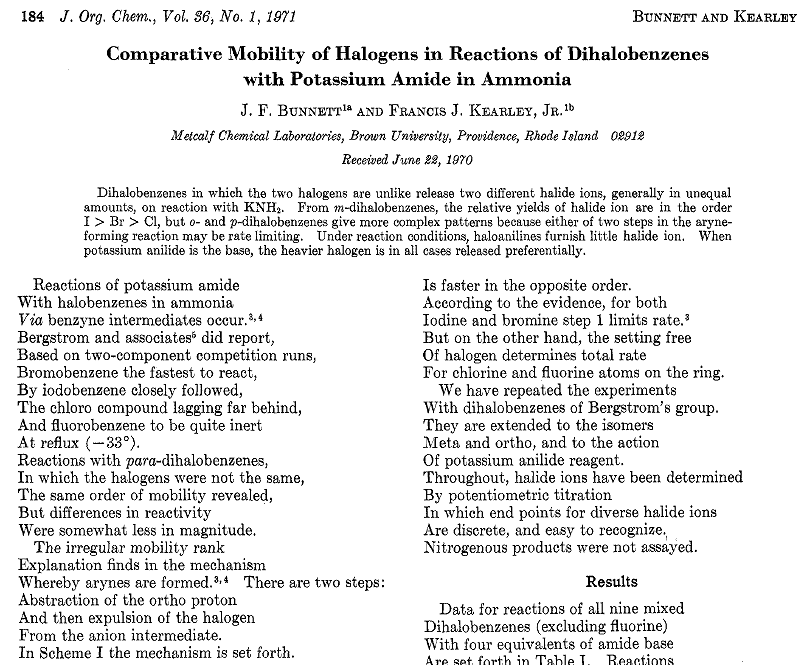
Spoof articles
Sometimes scientists like to write spoof or fake articles in order to draw attention to predatory Journals that will publish literally anything, no matter how ridiculous, so long as someone pays them to do so.
- A superb example of such an article is 'What's the deal with Birds?' published in Sci J. Res. and Rev. 2 2020. The abstract should really have given the Journal a clue as to its quality: "Many people wonder: what’s the deal with birds? This is a common query. Birds are pretty weird. I mean, they have feathers. WTF? Most other animals don’t have feathers. To investigate this issue, I looked at some birds. I looked at a woodpecker, a parrot, and a penguin. They were all pretty weird! In conclusion, we may never know the deal with birds, but further study is warranted. The Journal will probably retract the paper once they realise they've been fooled - but you can find a copy here.
- Charles Turner tells me that a group of Serbian scientists who were fed up with the poor quality of science coming from their country, and blamed it on referees allowing anything to be published, proved it by writing a spoof paper which appeared unchanged in the Journal Metalurgia International. The paper entitled "Evaluation of transformative hermeneutic heuristics for processing random data" included references by Michael Jackson and porn-star Ron Jeremy, citations to new studies by Bernoulli and Laplace (both dead more than 180 years), and to a researcher named, dubiously, “A.S. Hole.” Also they referenced the noted Kazakh polymath B. Sagdiyev, otherwise known as Borat. The article can be seen here.
- Charles Turner sent me this one, too. In April 2020, President Trump mentioned in a press briefing that it might be worth scientists looking into injecting disinfectant or internal use of UV light as potential cures for COVID19. Scientists wrote the following spoof article in response! The authors' names are also spoof: Trapper John MD is from the TV series of the same name, Andre Young is rapper Dr Dre, Douglas E. Powers is Dr Evil (from the Austin Powers' movies), Meredith Grey is the doctor in Grey's Anatomy, and Amanda Kerri is a comedienne.
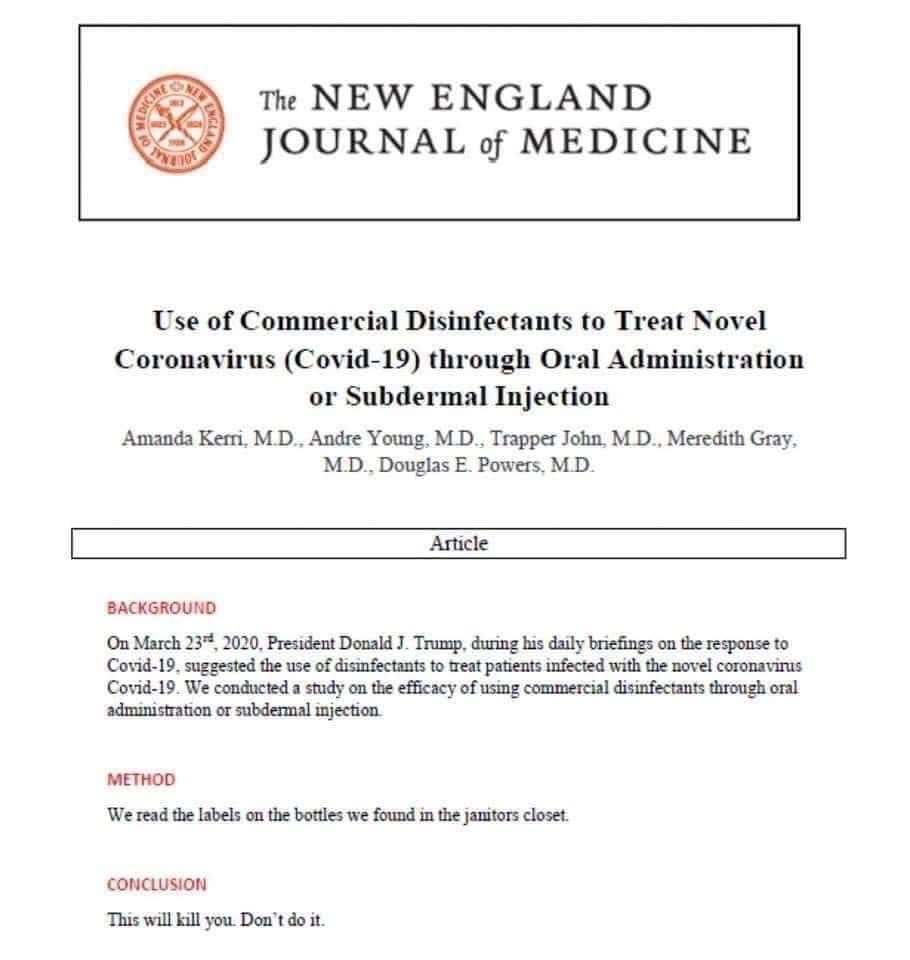
- One of most ridiculous spoof papers was written by Doug Zongker, a PhD student at the University of Washingtom more than a decade ago. As a parody of unintelligible scientific presentations, the presentation: “Chicken Chicken Chicken: Chicken Chicken.” which contains only the word 'chicken' written hundreds of times, including graphs (labelled with 'chicken') and tables (with headings of... 'chicken') was given at the annual meeting of the American Association for the Advancement of Science, and the hilarious video still exists! A pdf copy of the conference proceedings paper is also available, a portion of which is given below.

- A number of other spoof scientific articles can be found on the YouTube Video: The Best Science Hoaxes, Spoofs, and Nerd Jokes, by Sabine Hossenfelder.
Proteins and Genetics
- Tavi searched through the Online Mendelian Inheritance in Man database of proteins, and found the following proteins: relaxin, survivin, fidgetin, fukutin, antiquitin, mortalin, prohibitin, herculin, giantin, orphanin, semaphorin, arrestin, defensin, recoverin, cabin, rabin, rasputin, and aladin. And Mark Isaak told me of another protein called stargazin which derives from mutant epileptic mice that just lie and their backs and stare at the stars... Rob Towart also told me of another protein called dynamitin [ref: J. Biol. Chem. 282 (2007) 19355] that disassembles (i.e. blows up) a multiprotein complex. There's also a protein involved in brain development which has been given the name homer after that famous intellectual Homer Simpson.
- Similarly, Jan Linders tells me that stingins are peptides derived from bee venom, while Rob Towart found a nice protein called collapsin. He asked whether that was a protein found in cheap Spanish wine, which in Scotland is known as "vino collapso" (for obvious reasons, including the quantity consumed).
Jan also told me about a cold-sensitive mutation in a set of genes, suitably called BRR, which stands for Bad Response to Refrigeration)!
- Professor Anthony Nicholls gave me a link to the Apoptosis Glossary, which is full of weirdly named proteins. Apoptosis is a Greek word meaning 'the dropping of leaves from a tree'. It describes the common morphological changes that characterize the process of cellular self-destruction. The site has many strange names for these proteins and enzymes, including: Bad, Boo, CARDIAK, Casper, CLAP, DEDD, MADD, SODD, TANK, TRAMP, TRANCE, and TWEAK, to name but a few.
- Joe Fortey found some more involved in blood clotting called: tissue factor, convertin, preconvertin, accelerin, thrombomodulin, stuart and christmas.
- and Duncan Wiles found a protein which when absent from the plant Arabidopsis results in an altered leaf morphology. For this reason (and probably also for a laugh) its discoverers' termed it Knobhead.
- and Helen Webb and Shane Liddelow told me that recently a new kinase enzyme was identified and was called "JAK", which actually stands for JAnus Kinase (named after the 2-faced God Janus since it has two phosphate-transferring domains. Some biochemists also say that JAK stands for "just another kinase".

- Thomas Schneider from the National Cancer Institute in Maryland told me about a protein called Dam Methylase, which is part of the 'dam modification gene' of E. coli. And Mirela Matecic has been working with a whole series of yeast proteins called SIR. The are know as 'Sir Silencer' molecules because they are involved in silencing and repression, although they sound more like one of King Arthur's Knights of the Round Table. Another strangely-named protein is called 'the DEAD box' after its amino acid conserved sequence (emailed to me by Israel Barrantes).
- Brandi Baros from Allegheny College, Meadville, PA., told me that she did her graduate work in the lab of Roger Hendrix, who is well-known in the bacteriophage (viruses that infect bacteria) circles for having a sense of humour to go with his great science. Going along with the convention that functional chunks of nucleic acid usually have names ending in -on (for example, the coding group of 3 DNA or RNA bases is a codon, while a group of related genes in bacteria that are translated at once is the operon, and the entirety of DNA that a bacterium replicates is the replicon; in eukaryotes we have the expressed gene sequences known as exons that are interrupted by the intruding introns), he came up with a new name for an odd phenomenon in bacteriophage genomes. He found related phages where one phage's genome had odd insertions than made them have more DNA in certain places than the other phages in the related group. Since these insertions seemed to be somewhat random but caused the phage to have more DNA than its cousins, the insertion was named a "moron". The reference for the paper is: J. Mol. Biol. 299 (2000) 27, from which we get the quote: "To provide a simple way to refer to these DNA segments, we propose to give them the name, moron, to indicate the fact that when one is present in the genome there is more DNA than when it is not present."
- David Sogg told me about two presynaptic proteins called Bassoon and its smaller partner Piccolo. They are named this because they are involved in 'orchestrating' events at the nerve terminal.
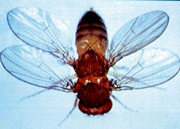 Joerg Heim emailed me to say that a very well known German Drosophila geneticist (name omitted for discretion) told him once that he prefers to name the most ugly/lethal mutants after lab-personnel, and the nice ones after his wife (and several nicknames). Charles Turner also found a whole load of genes that have been given silly names, including:
Joerg Heim emailed me to say that a very well known German Drosophila geneticist (name omitted for discretion) told him once that he prefers to name the most ugly/lethal mutants after lab-personnel, and the nice ones after his wife (and several nicknames). Charles Turner also found a whole load of genes that have been given silly names, including:
- Lunatic Fringe and Radical Fringe, reported in Science, 273, 19 July 1996.
- Cockeye (also in the Drosophila fruit fly),
- Clootie Dumpling and Currant Bun (http://www.dundee.ac.uk/anatphys/molgenet.htm)
- Exuperantia - Drosophila; an anterior defect mutant named after a Christian slave who was beheaded along with his masters but was, despite his martyrdom and unlike his masters, denied sainthood due to his slave status. (http://sdb.bio.purdue.edu/fly/torstoll/exuper1.htm)
- Faint Sausage - Drosophila heart morphogenesis gene (http://www.neuroscience.ucla.edu/faculty-page.asp?key=50)
- INDY - acronym for 'I'm Not Dead Yet'; a Drosophila mutation which allows it to live twice as long (http://whyfiles.org/shorties/070old_fly/)
- Mothers Against Decapentaplegic and Daughters Against Decapentaplegic - are mutation enhancing Drosophila genes (http://sdb.bio.purdue.edu/fly/newgene/mothadpp.htm)
- Tinman - literally a heartless Drosophila mutant
- ZapA - a gene named for musician Frank Zappa. This gene codes for a protease in the common bacterium
Proteus mirabilis. (http://homepage.ntlworld.com/andymurkin/Resources/MusicRes/ZapRes/ZapA.html)
- Snafu - 'Snafu' is an American military acronym for 'Situation Normal All F**ed Up'. In Drosophila, the embryos are initially normal but become progressively abnormal with developmental time and continued cellular mitosis due to the snafu mutation. (http://flybase.bio.indiana.edu/.bin/fbidq.html?FBgn0061481)
- Gleeful - This gene encodes a C2H2 zinc finger transcription factor with high sequence similarity to vertebrate Gli proteins, so the gene has been named gleeful (Ggl).[Furlong et al., Science 293:1632].
- Hamlet - Named for Hamlet's "to be or not to be" soliloquy because it affects development of cells descended from the Drosophila IIB cells. [Science 297:1355].
- Callipyge - is Greek for 'beautiful buttock'. A group at Duke University have isolated the callipyge gene. A mutation in this gene lets sheep convert food into muscle 30 percent more efficiently yielding sheep with "big and muscular bottoms". The bottoms of the sheep which carry this mutant callipyge have very little fat, so the gene could shed light on obesity and fat metabolism.
- Stuck gene - another fly gene which causes the male flies to become stuck in the females after copulation because 'appendages of their terminalia are held in aberrantly protruding positions'. They should be so lucky...
- Pokemon gene - which stands for POK Erythroid Myeloid ONtogenic factor (thanks to Jenni Vedenoja for this one).
- Happyhour - it provides increased resistance to the sedative effects of alcohol! [Cell 137, (2009) 949–960.]
And he also found the following in Harper's Magazine (June 2002): "From Flybase, a database of fruit-fly genes maintained by a consortium of research institutions. The genes were named by the researchers who discovered them. Convention suggests that if the genes' human counterparts are discovered, they will be given the same names:
- aloof, always early, amontillado, bang senseless, bang sensitive, bride of sevenless, brother of odd with entrails limited, bumper-to-bumper, couch potato, crack, crossbronx, Daughter killer, daughter of sevenless, Deadpan, deathknell, Dinty, disco-related, dog of glass, effete, eggroll, enoki mushroom, escargot, ether a go-go, fear-of-intimacy, fuzzy onions, genghis khan, glass bottom boat, Godzilla, Grunge, gut feeling, helter-skelter, he's not interested, hoi-polloi, In dunce, inebriated, jekyll and hyde, just odd knobs, ken and barbie, king tubby, klingon, ladybird early, ladybird late, lemming, Lesbian, long island expressway, maelstrom, Malvolio, members only, mozzarella, naked cuticle, nanking, okra, out at first, oxen, pacman, papillote, pentagon, pugilist, quagmire, quick-to-court, redtape, Revolute, roadkill, rolling stone, sawtooth, scab, scott of the antarctic, scruin like at the midline, sevenless, Sex lethal, shank, similar to Deadpan, singles bar, slamdance, spotted dick, stranded at second, super sex combs, Thor, thousand points of light, Trailer hitch, vibrator, viking."
- Similarly, Thorsten Müller told me about the basic research on the immune system and developmental biology of fruit flies by Christiane Nüsslein-Volhard and colleagues. They have also given unusual and descriptive names (in German) to the mutated proteins leading to a changes in the flies. Examples are the proteins spätzle (Swabian noodles), cactus, huckebein (hunchback), gurken (gurkin, cucumber) and krapfen (doughnut). Furthermore, spätzle binds to a Toll-like receptor (Toll means amazing). They named it the Toll-Protein because they found it pretty amazing.
- On the same theme, Phill Baker from the University of New Mexico told me about a gene that he worked on in his lab called TINA1, which was named after the undergraduate student Tina Nguyen who was responsible for a large part of the data collected on that gene.
- Also, Joe Bobich told me about a particular mutated protein (later called dynamin) in a fruit fly, which was named with an appropriate Japanese word; shibire. However, the Japanese was chosen so that the temperature sensitive form of the "shi" mutation would have to be named shits. (See for example, Guha et al. J. Cell Sci. 116, (2003) 3373-3386.)
- Although it's not a molecule, Leigh Arino de la Rubia told me about a bacteriophage (a virus that infects a bacterium) called Corndog, after its unusual shape.
- Kay Dekker also tells me about a human protein which mediates the transbilayer movement of plasma membrane phospholipids, and is called 'Scramblase'. It got its name since it can transport (scramble) the negatively-charged phospholipids from the inner-leaflet to the outer-leaflet of a cell wall, and vice versa. There are five scramblases in humans are members of the larger family of phospholipid translocators known as flippases.
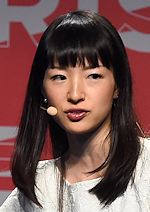 Jan Linders told me about a newly discovered protein in fruit fly embryos that destroys maternal proteins that was published recently [eLife (2020) 9, e53889]. This gene removes unnecessary molecules, keeping embryos organized, and free of clutter. So they named it Marie Kondo (photo, right) after the well-known TV presenter who is famous for tidying up, and who hosted the 2019 Netflix series Tidying Up with Marie Kondo.
Jan Linders told me about a newly discovered protein in fruit fly embryos that destroys maternal proteins that was published recently [eLife (2020) 9, e53889]. This gene removes unnecessary molecules, keeping embryos organized, and free of clutter. So they named it Marie Kondo (photo, right) after the well-known TV presenter who is famous for tidying up, and who hosted the 2019 Netflix series Tidying Up with Marie Kondo.
Geochemical Funnies
- Grenville Turner emailed me to say that the name geologists give to a rock or mineral which is impossible to identify is Fubarite, since 'fubar' is the notorious acronym (f**ked up beyond all recognition). And similarly, Kay Dekker emailed me to say that he wished that some geologist or mineralogist called Webbs would get out there and discover 'Webbsite'. Also, Heather Wood tells me that geologists give the name 'leverites' to a rocks that have nothing interesting to distinguish them and only take up room in your backpack. A typical exchange:
New Student: What's this?
Smart-ass Professor: A leverite.
New Student: A leverite?
Smart-ass Professor: If I were you, I'd leave 'er right there.
- In the same vein, Iain Fielden from Sheffield-Hallam University said:
Metallurgists are also great ones for naming a material, or variant, as something-ite. Classic examples are various forms of steel, Austenite (face centre cubic crystal form, discovered by Austen), ferrite (normal room-temperature body centered cubic form), pearlite (it looks
like mother of pearl, but only if viewed through a low quality microscope, such as was the best available in late Victorian/early 20th century times), Bainite and Martensite (different distributions of iron carbide in ferrite, produced by different heat treatments).
When a steel has been heat-treated wrongly, the result is usually a complex (and useless) mixture of at least two of Martensite, Bainite and pearlite. In some labs, these mixed structures are occasionally referred to as "Bagashite" or "Pileashite", though never when the customer is visiting.
Example:
Metallurgist 1: (looking through microscope at the suspect piece of metal)
"Well, its not the tempered Martensite that the spec. says it should be."
Metallurgist 2: "So what is it then?"
Met 1: "I think it's Bagashite. Here, you take a look, what do you think?"
"Crockashite" has also been proposed as a generic name for new wonder materials for which poorly substantiated, purely theoretical or somewhat optimistic claims are made. For example:
"Of course all this will be superceded when nanotube composites become available"
"True, but that does pre-suppose that it's possible to produce quality nanotubes, in quantity, and at the right price. Until then, its just Crockashite."
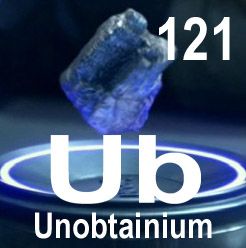 And similarly, Darren Sydenham told me that in Australia the government tertiary education classes were nicknamed 'tech' by the students. In Geology lessons, when asking their lab supervisor about the mineral Tectonite, the students would ask 'Do we have tectonite?'. If the answer was no, they'd all go home!
And similarly, Darren Sydenham told me that in Australia the government tertiary education classes were nicknamed 'tech' by the students. In Geology lessons, when asking their lab supervisor about the mineral Tectonite, the students would ask 'Do we have tectonite?'. If the answer was no, they'd all go home!
- David Luer sent me the following joke: What's the definition of a mineralogist? It's a person who can take one look at a platinum blonde and tell instantly if she's a virgin metal or a common ore!
- In the movie Avatar, the mysterious mineral that the miners were after was called 'unobtainium'. It turns out that this wasn't just a silly name made up by the screenwriters - the use of the name unobtainium to mean 'a chemical which has all the desired properties but impossible to get hold of' has a long scientific history. The full story is here (provided by Charles Turner). Also, in the X-Men movies, Wolverine's talons and skeleton are supposedly made from a superhard material called adamantium. This is fictitious, of course, but the name is based on adamantane (the cage molecule that's the building block for diamond) and means 'unbreakable' in Greek.
- Recently, it was reported that new mineral has been identified in a mine in Serbia that has the same chemical formula as Superman's kryptonite - sodium lithium boron silicate hydroxide. This is same scientific name that was written on a case of rock containing kryptonite stolen by Lex Luthor from a museum in the film 'Superman Returns'. The new mineral does not contain fluorine (which it does in the film) and is white rather than green but, in all other respects, the chemistry matches that for the rock containing kryptonite. Unfortunately, the mineral cannot be called kryptonite under international nomenclature rules because it has nothing to do with krypton gas. Instead, it will be formally named jadarite since Jadar is the name of the place where the Serbian mine is located.
- Charles Turner has sent me the definition of the mineral Cactolith, which is: "A quasi-horizontal chonolith, composed of anastomising ductoliths, whose distal ends curl like a harpolith, thin like a sphenolith, or bulge discordantly like an akmolith or ethmolith." This definition was coined by the US Geological Survey geologist Charles Butler Hunt, as a satirical jab at the absurd geological terms that were proliferating faster than rabbits, and at the many geologists who seemed to be taking themselves too seriously. He later went on to publish the books "How to collect Mountains" and "Dating mining camps with tin cans and bottles". [Ref: C.B. Hunt, Geology and geography of the Henry Mountains region, Utah, 1953].
Equipment and Techniques
- When a new type of mass spectrometry was invented, the inventors must have tried very har to come up with a suitable name for it. They ended up with the Contaminant Repository for Affinity Purification, or the CRAPome for short.
- Tometomo Hamaguchi, a chemistry student at York University, emailed me to say that a standard technique in NMR spectroscopy is called Spin Echo Correlated (or Correlation) SpectroscopY, or SECSY for short. Moreover, Lily Zhou from Michigan University told me that COrrelated SpectroscopY is COSY, FOldover Corrected Correlation SpectroscopY is called FOCSY, Nuclear Overhauser Enhancement SpectroscopY is NOESY, and Insensitive Nuclei Enhanced by Polarization Transfer is INEPT. And Tom Bisschops tells me that there is another NMR experiment which goes by the name INADEQUATE (Incredible Natural Abundance Double Quantum Transfer Experiment), while Eric Winegar says there's even one called PENIS (Proton Enhanced Nuclear Induction Spectroscopy). This means you can have FOCSY NMR technicians sitting in their COSY labs creating SECSY spectra for you, while the nearby NOESY, INEPT professor examines his INADEQUATE PENIS...
- There's also a link to a list of crazy NMR acronyms, which include: BIRD, CAMELSPIN, CHIRP, CRAMPS, DIGGER, DOUBTFUL, FLOPSY, FUCOUP, GRASP, GROPE, HOHAHA, PRESS, STEAM, STUD, SUSAN, WATERGATE, and WURST.
- Not to be outdone, laser chemists have come up with an acronym for multiple population-period transient spectroscopy, which is MUPPETS.
- J.J. Keating from University College Cork in Ireland told me of another superb name for a chemical process, ROMP, short for 'Ring Opening Metathesis Polymerization' [M.E. Piotti, Curr. Opinion in Solid State and Mater. Sci. 4, (1999) 539]. It's used to split open olefinic rings, thereby relieving the bond strain, to make long-chained polymers. So, if the molecular ring in question was an arsole, we'd have...wait for it... a strained arsole ROMP resulting in ring splitting!
- But I think the best acronym of all for a scientific technique was sent to me by Charlie Bond. It's for Angle-Resolved Spin-Polarised Inverse Photoemission Spectroscopy, or ARSPIPES for short! If you don't believe me, see: Surf. Sci. 377-379 (1997) 229.
- Another excellent, contrived acronym sent to me by Charles Turner is RUN-DMC, which stands for Radial velocity Using N-body DEMCMC.
- And on a related theme, David Louis Proctor from Cornell University tells me that in the field of femtosecond laser spectroscopy, there is a is a family of techniques which allow the measurement of the pulse using a copy of the pulse as a measuring tool. The first of these techniques is Frequency Resolved Optical Gating, or FROG. Another version is GRating-Eliminated No-nonsense Observation of Ultrafast Incident Laser Light E-fields (GRENOUILLE, which is French for frog).
And similarly, James Landon tells me that the world of Computational chemistry uses the 'qp matrix' in the calculation of certain molecular dynamics problems. Since 'qp' sounds like Kewpie (the doll maker), the algorithm is called the DOLLS algorithm. This is taken a step further, with the reverse process giving rise to the SLLOD algorithm.
Chemical Anecdotes
- Robert Grossman told me that there was a style of handwriting in medieval times called minim handwriting, so called because the letters i, n, and m were written as follows:
 . There is a class of organic compounds called iminium ions, R2N+=CR2. In minim handwriting, "iminium" would be written like this:
. There is a class of organic compounds called iminium ions, R2N+=CR2. In minim handwriting, "iminium" would be written like this: 
- Naomi Lipsky emailed me and said that she'd once had the good fortune to attend a talk by Sir Hans Krebs. He said one of the questions he oftens gets is: how did he know the Krebs Cycle turned clockwise?
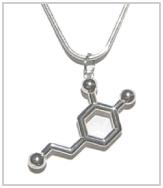 For those of you wishing to wear your favourite molecule as an item of jewelery, the website 'The Molecule Store' is the place to go. Here you can buy necklaces, bracelets, cufflinks and pendants (see photo, right) made fom silver and gold, shaped into the structures of molecules such as capsaicin (chilli), theobromine (chocolate), caffeine, etc. Other companies, such as Dopamine Jewelry, sell pieces made from microscopic photos of "behavior-altering chemicals" like acetylcholine and Chablis, while The DNA Store offers gold double-helix earrings and an enamel X chromosome pin, and DNA Stuff features double-helix bracelets and gold helix tie-tacks. [Thanks to Jan Linders for these links].
For those of you wishing to wear your favourite molecule as an item of jewelery, the website 'The Molecule Store' is the place to go. Here you can buy necklaces, bracelets, cufflinks and pendants (see photo, right) made fom silver and gold, shaped into the structures of molecules such as capsaicin (chilli), theobromine (chocolate), caffeine, etc. Other companies, such as Dopamine Jewelry, sell pieces made from microscopic photos of "behavior-altering chemicals" like acetylcholine and Chablis, while The DNA Store offers gold double-helix earrings and an enamel X chromosome pin, and DNA Stuff features double-helix bracelets and gold helix tie-tacks. [Thanks to Jan Linders for these links].
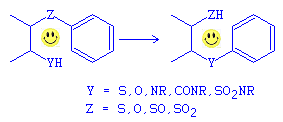 Leon Mathiasen from the University of Aarhus, Denmark, tells me that a famous organic reaction is called the Smiles Rearrangment (right), and organic chemists use it to cheer themselves up after a hard day in the lab.
Leon Mathiasen from the University of Aarhus, Denmark, tells me that a famous organic reaction is called the Smiles Rearrangment (right), and organic chemists use it to cheer themselves up after a hard day in the lab.
- Shadowfox told me a rather rude anecdote: He overheard someone asking what dicumyl peroxide was, and someone muttered: "It's semen after wiping it off a fake blonde's hair!"
- Charles Turner told me that in the 1999 anagrammy awards, which are given for the best anagrams of the year, Mike Keith won with this astonishing anagram of the names of 30 elements which are an anagram for the names of 30 other elements. Moreover, the sum of their atomic numbers is also the same!
hydrogen + zirconium + tin + oxygen + rhenium + platinum + tellurium + terbium + nobelium + chromium + iron + cobalt + carbon + aluminum + ruthenium + silicon + ytterbium + hafnium + sodium + selenium + cerium + manganese + osmium + uranium + nickel + praseodymium + erbium + vanadium + thallium + plutonium |
= |
nitrogen + zinc + rhodium + helium + argon + neptunium +
beryllium + bromine + lutetium + boron + calcium + thorium +
niobium + lanthanum + mercury + fluorine + bismuth + actinium +
silver + cesium + neodymium + magnesium + xenon + samarium +
scandium + europium + berkelium + palladium + antimony + thulium |
| [This is a "doubly-true anagram" - if you replace each element with its atomic number, there is still equality] |
1 + 40 + 50 + 8 + 75 + 78 +
52 + 65 + 102 + 24 + 26 + 27 +
6 + 13 + 44 + 14 + 70 + 72 +
11 + 34 + 58 + 25 + 76 + 92 +
28 + 59 + 68 + 23 + 81 + 94
[= 1416] |
= |
7 + 30 + 45 + 2 + 18 + 93 +
4 + 35 + 71 + 5 + 20 + 90 +
41 + 57 + 80 + 9 + 83 + 89 +
47 + 55 + 60 + 12 + 54 + 62 +
21 + 63 + 97 + 46 + 51 + 69
[= 1416] |
- And similarly, Charles Turner also sent me a list of chemical name superlatives:
- FORMALDEHYDETETRAMETHYLAMIDOFLUORIMUM is the longest word in which no letter occurs only once.
- HYDROXYZINE (a prescription drug) is the only word in most of the main dictionaries containing XYZ. XYZAL is a newer prescription drug which has yet to make it intothe dictionaries.
- HYDROXYDESOXYCORTICOSTERONE/HYDROXYDEOXYCORTICOSTERONES are examples of long transposal word (words which are anagrams of each other).
- The longest 'perfectly mixed' transposals (no consecutive letter combinations) are the fourteen letter words NITROMAGNESITE/REGIMENTATIONS and ROTUNDIFOLIATE/TITANOFLUORIDE.
- The longest 'well-mixed' transposals (no more than three consecutive letters in common) are the sixteen-letter words BASIPARACHROMATIN/MARSIPOBRANCHIATA (17 letters) and THERMONASTICALLY/HEMATOCRYSTALLIN
- GLYCYLGLYCYLGLYCYLGLYCINE has a 19-letter internal palindrome from the first to the last C and another 19-letter palindrome from the first G to the last G.
- 6,8-DIDEOXY-6-(1-METHYL-4-PROPYL-2-PYRROLIDINECARBOXAMIDO)-1-THIO-D-ERYTHRO-D-GALACTO-OCTAPYRANOSIDE (100 characters including punctuation) is found in the OED2, although as a citation for the word lincomycin and not as a vocabulary entry.
- DIISOBUTYLPHENOXYETHOXYETHYLDIMETHYLBENZYLAMMONIUMCHLORIDE has appeared in the J. of Am. Vet. Med. Assoc. It is the chemical name of a drug they announced in the 1950s.
- VRBAITE (a mineral named after Karel Vrba) which is pronounced with a vowel that is not represented in its spelling. This is because R can serve as a vowel in Czech.
- ARGININOSUCCINICACIDURICALLY is a 28 letter word with no 'E's.
- A 2016 article in Pharmacy Times listed 12 difficult-to-pronounce drug names. Number one was TALIMOGENE LAHERPAREPVEC.
- HYPoThAlAmICoHYPoPHYSeAlS is the longest word that can be spelled using chemical symbols. Other such words include NONRePReSeNTaTiONAlISmS, BrONCHOEsOPHAgOSCOPIEs, ThErMoPHOSPHOReSCeNCe, HYPSIBRaCHYCePHAlISm, HYPErPHOSPHOReSCeNCe, SUPErCoNdUCTiVITiEs, PARaPrOFeSSiONaLS, and SUPErSOPHISTiCAtE. IrReSPONSiBILiTiEs reuses no element’s symbol. PrAcTiCaLiTiEs may be the longest word using only two-letter abbreviations, or PaRaCrOsTiCs if no elements are repeated.
- Benzhydroxamic and sulphogermanic are fourteen letter words in which no letter appears more than once.
- Aluminosilicates is a sixteen-letter word consisting strictly of alternating consonants and vowels. Hexosaminidases is a fifteen-letter word with this property.
- Charles Turner told me that scientists often play games when writing papers or reports. A 2014 report revealed that a group of Swedish academics have had a 17-year bet: whoever has written most articles including Bob Dylan quotes before going into retirement would win a free lunch. The bet began in 1997, following publication of a paper by Jon Lundberg and Eddie Weitzberg, Nitric Oxide and Inflammation: The Answer Is Blowing In the Wind. “We both really like Bob Dylan so when we set about writing an article concerning the measurement of nitric oxide gas in both the respiratory tracts and the intestine... the title came up and it fitted there perfectly,” explained Weitzberg.
Several years later a librarian pointed out that two of the scientists’ colleagues, Jonas Frisén and Konstantinos Meletis, had used a different Dylan reference in a paper about the ability of non-neural cells to generate neurons: Blood on the Tracks: A Simple Twist of Fate?. Soon the bet was on: The one who has written most articles with Dylan quotes, before going into retirement, wins a lunch at a local restaurant. Word spread quickly through the Karolinska Institute in Stockholm where all four men work, and before long there was a fifth competitor: Kenneth Chien, a professor of cardiovascular research. By the time he met the others, he already had one Dylan paper to his name – Tangled Up in Blue: Molecular Cardiology in the Postmolecular Era. With five competing rivals, the pace of Dylan references accelerated. Lundberg and Weitzberg’s The Biological Role of Nitrate and Nitrite: The Times They Are a-Changin’, in 2009; Eph Receptors Tangled Up in Two in 2010; Dietary Nitrate – A Slow Train Coming, in 2011. As far as I know, the bet still continues...
 Charles Turner pointed out that Gerti Cori received the Nobel Prize for her work on carbohydrate metabolism and became the third woman and first American woman to do so. In 2008, the US Post Office recognized her (along with Edwin Hubble, Linus Pauling, and John Bardeen) on a postage stamp, showing her portrait and a molecule, the Cori ester, she discovered. They decided to go ahead and issue the stamp despite the fact that there is an error in the chemical formula for the molecule. In case you haven't spotted it, the error is that the bond to the phosphate group should go to the first O, not the second.
Charles Turner pointed out that Gerti Cori received the Nobel Prize for her work on carbohydrate metabolism and became the third woman and first American woman to do so. In 2008, the US Post Office recognized her (along with Edwin Hubble, Linus Pauling, and John Bardeen) on a postage stamp, showing her portrait and a molecule, the Cori ester, she discovered. They decided to go ahead and issue the stamp despite the fact that there is an error in the chemical formula for the molecule. In case you haven't spotted it, the error is that the bond to the phosphate group should go to the first O, not the second.
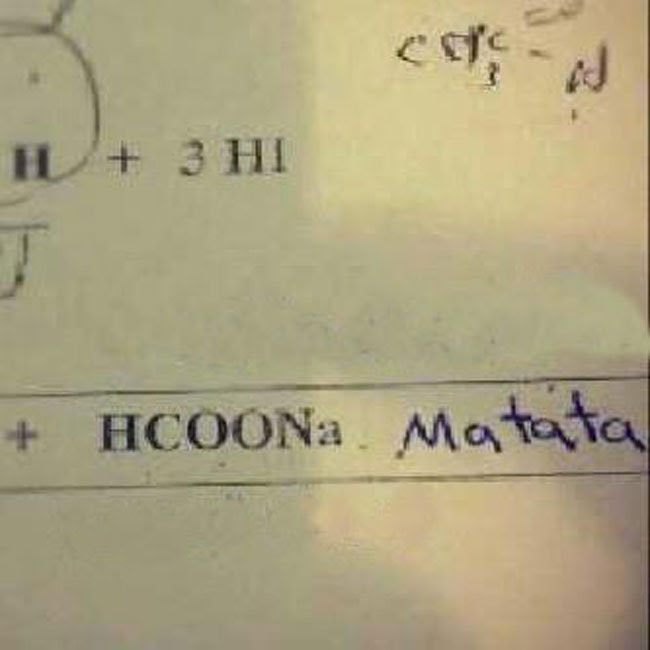 He also sent me the best ever Chemistry exam answer, shown in the image on the right.
He also sent me the best ever Chemistry exam answer, shown in the image on the right.
 Eddie Luzik also emailed me to say that in the 1998-9 edition of the Aldrich chemical catalogue there was a strange set of index headers on some pages. These index headers just contain a shortened version of the first chemical name on that page, for ease of searching. On pages 1579, 1580 and 1581 there is tetraKISME, tetraKISSU and then tetrALONE. Maybe this has some deeper meaning for the state of chemists' dating skills... (The full names of the molecules are: [1,2,3,4-Tetrakis(methoxy-carbonyl)-1,3-butadiene-1,4-dyl]palladium, 5,10,15,20-Tetrakis(4-sulfonatophenyl)-21H,23H-porphine manganese(III), and Tetralone. Unfortunately, in the new edition of the catalogue these molecules appear lower down the pages, so they no longer appear in the headers...).
Eddie Luzik also emailed me to say that in the 1998-9 edition of the Aldrich chemical catalogue there was a strange set of index headers on some pages. These index headers just contain a shortened version of the first chemical name on that page, for ease of searching. On pages 1579, 1580 and 1581 there is tetraKISME, tetraKISSU and then tetrALONE. Maybe this has some deeper meaning for the state of chemists' dating skills... (The full names of the molecules are: [1,2,3,4-Tetrakis(methoxy-carbonyl)-1,3-butadiene-1,4-dyl]palladium, 5,10,15,20-Tetrakis(4-sulfonatophenyl)-21H,23H-porphine manganese(III), and Tetralone. Unfortunately, in the new edition of the catalogue these molecules appear lower down the pages, so they no longer appear in the headers...).
- And on the subject of school, Tim Harrison reminded me about the standard test for the nitrate ion, called the brown ring test. I remember doing this in Chemistry practicals at school, and several students shouting 'Hey, look at my brown ring!', and 'My ring is browner than your ring!'.
- I recently read a paper that thanked an American Foundation for funding the work. It was called the John and Fannie Hertz Foundation. Fannie Hertz!...you couldn't make it up!
- Also, Alain Gottcheiner told me that the element strontium causes amusement in Dutch-speaking countries since in Dutch, 'stront' means 'turd'. It was actually named after the the village of "Strontian" in Scotland, where it was discovered. I wonder if the inhabitants of that village know what the village's name means in Dutch...? In fact, Alan Jackson emailed me to give further info about the name. Strontian - Sron an t-Sithein - means "The Fairy's Nose", the 'Nose' being a peninsula into Loch Suinart. The mineral was discovered in a mine within the nose, back in the days when miners used pickaxes. Therefore Strontium was the only element to have been discovered by picking someone's nose!
- Still on the subject of elements, Charles Turner also told me about some examples of element etymology, taken from Isaac Asimov's "Book of Facts":
It would be improper for a scientist to name a discovery after himself. Thus, when the French chemist
Paul Emile Lecoq de Boisbaudran discovered a new element in 1874 he named it "gallium" after Gallia,
the Latin name for what is now France. However, le coq is "the rooster" in French, and gallus is "rooster" in Latin. There is at least a suspicion that Lecoq de Boisbaudran was doing a little crowing on his own.
Only one of the eighty-one stable chemical elements is named after a human being. It is gadolinium, which is named for a Finnish chemist, Johan Gadolin, who first studied the minerals from which no less than fourteen elements, including gadolinium, were isolated.
Four of the chemical elements are after the hamlet of Ytterby near Stockholm, where the minerals containing them were first located. The elements are erbium, terbium, yttrium, and ytterbium. In contrast, France, Germany, Russia, and the United States have one element apiece named in their honor. They are francium (and also gallium, see above), germanium, ruthenium, and americium. Alas, Great Britain has none...except for maybe strontium which, as Sheila Glidewell pointed out to me, was named after the Scottish town Strontian, in the Argyllshire district, where strontium carbonate mineral was first identified in the late 18th century.
And finally, there is a nice story about the element cobalt, which is named after the evil spirit the kobald, which rumour said haunted mines and poisoned the miners.
- Charles Turner also told me about British-born neurologist Oliver Sacks' boyhood memoir "Uncle Tungsten - Memories of a Chemical Boyhood". Here are a couple of quotes concerning the proposed names for elements that are amusing:
-
"In addition to the hundred-odd names of existing elements, there were at least twice that number for elements that never made it, elements imagined or claimed to exist on the basis of unique chemical or spectroscopic characteristics, but later found to be known elements or mixtures: "alabamine", "bohemium"... I was oddly moved by these fictional elements and their names, especially the starry ones. The most beautiful, to my ears, were "aldebaranium" and
"cassiopeium" (Auer's names for elements that actually existed, ytterbium and lutetium) and "denebium," for a mythical rare earth. There had been a "cosmium" and "neutronium" ("element 0"), too, to say nothing of "archonium," "asterium," "aetherium," and the Ur-element "anodium," from which all the other elements supposedly were built.
Other obsolete or discredited names also referred to actual elements: thus the magnificent "jargonium," an element supposedly present in zircons and zirconium ores, was most probably the real element hafnium."
"Although elements 93 and 94, neptunium and plutonium, were created in 1940, their existence was not made public until after the war. They were given provisional names, when they were first made, of "extremium" and "ultimium," because it was thought impossible that any heavier elements would ever be made. Elements 95 and 96, however were created in 1944. Their discovery was not made public in the usual way---in a letter to NATURE, or at a meeting of the Chemical Society---but during a children's radio quiz-show in November 1945, during which a twelve-year-old boy asked, "Mr. Seaborg, have you made any more elements lately?"
- Charles Turner also told me that, according to the November 2005 issue of Discover magazine, Seaborg named his newly discovered element 94 Pluto after the recently discovered (and even more recently demoted) planet Pluto. "Seaborg chose the letters Pu as a joke, which passed without notice into the periodic table." (Since PEEEE-YEEWWW is an interjection indicating a bad stench).
- Staying with Seaborg(ium), not only was [Glenn] Seaborg, who worked at the Lawrence Livermore National Labs and at Berkeley University, the first living scientist to have an element named after him, he was the only person who could have received mail addressed only in elements: Seaborgium, Lawrencium Livermorium, Berkelium, Californium, Americium. [This is not strictly correct as the Lawrence Livermore National Lab is actually situated about 30 miles from Berkeley, although Seaborg was a Professor at UC Berkeley]. (Thanks to Charles Turner for this).
Kay Dekker recently pointed out to me that Seaborg isn't alone in being able to be addressed by elements: Ève Curie (Marie and Pierre's younger daughter) could almost certainly have been reached after World War II in Paris, where she was the co-publisher of the Paris-Press newspaper, with the address "Curium, Lutetium, Francium". Curium had been discovered in 1944; lutetium was named after Lutetia, the Latin name for Paris, and Francium was named after France.
- ...and also on the theme of element names, this is from the online encyclopedia Wikipedia: "Also called Radium F, polonium was discovered by Marie Curie and Pierre Curie in 1898 and was later named after Marie's home land of Poland. Poland at the time was under Russian domination, and not recognized as a nation. It was Marie's hope that naming the element after her home land would add noteriety to its plight. Polonium may be the first element named to highlight a political controversy."
- Charles Turner has also found a link to the chemical with the longest name in a scientific Journal. It is the 1,913 character long, 267 sequence amino acid, and is the full name for Tryptophan Synthetsase:
methionylglutaminylarginyltyrosylglutamylserylleucyl
phenylalanylalanylglutaminylleucyllysylglutamylarginyl
lysylglutamylglycylalanylphenylalanylvalylprolylphenyl
alanylvalylthreonylleucylglycylaspartylprolylglycylisol
eucylglutamylglutaminylserylleucyllysylisoleucylaspartyl
threonylleucylisoleucylglutamylalanylglycylalanylaspartyl
alanylleucylglutamylleucylglycylisoleucylprolylphenyl
alanylserylaspartylprolylleucylalanylaspartylglycylprolyl
threonylisoleucylglutaminylasparaginylalanylthreonylleucyl
arginylalanylphenylalanylalanylalanylglycylvalylthreonyl
prolylalanylglutaminylcysteinylphenylalanylglutamyl
methionylleucylalanylleucylisoleucylarginylglutaminyllysyl
histidylprolylthreonylisoleucylprolylisoleucylglycylleucyl
leucylmethionyltyrosylalanylasparaginylleucylvalylphenyl
alanylasparaginyllysylglycylisoleucylaspartylglutamylphenyl
alanyltyrosylalanylglutaminylcysteinylglutamyllysylvalyl
glycylvalylaspartylserylvalylleucylvalylalanylaspartylvalyl
prolylvalylglutaminylglutamylserylalanylprolylphenylalanyl
arginylglutaminylalanylalanylleucylarginylhistidylasparaginyl
valylalanylprolylisoleucylphenylalanylisoleucylcysteinyl
prolylprolylaspartylalanylaspartylaspartylaspartylleucyl
leucylarginylglutaminylisoleucylalanylseryltyrosylglycyl
arginylglycyltyrosylthreonyltyrosylleucylleucylserylarginyl
alanylglycylvalylthreonylglycylalanylglutamylasparaginyl
arginylalanylalanylleucylprolylleucylasparaginylhistidyl
leucylvalylalanyllysylleucyllysylglutamyltyrosylasparaginyl
alanylalanylprolylprolylleucylglutaminylglycylphenylalanyl
glycylisoleucylserylalanylprolylaspartylglutaminylvalyllysyl
alanylalanylisoleucylaspartylalanylglycylalanylalanylglycyl
alanylisoleucylserylglycylserylalanylisoleucylvalyllysylisol
eucylisoleucylglutamylglutaminylhistidylasparaginylisoleucyl
glutamylprolylglutamyllysylmethionylleucylalanylalanylleucyl
lysylvalylphenylalanylvalylglutaminylprolylmethionyllysyl
alanylalanylthreonylarginylserine.
A full description of this molecule and the history of its name is given at http://www.quinion.com/words/qa/qa-imm1.htm
- On the same topic of long molecule names, he also tells me that 6,8-DidEeoxy-6-(1-methyl-4-propyl-2-pyrrolidinecarboxamido)-1-thio-D-erythro-D-galacto-octapyranoside (75 letters and 15 hyphens, total 100 characters) is found in the OED2, although not as a vocabulary entry. Instead it appears in a citation for the word 'lincomycin'.
- Graham Sewell remembers that during his undergrad days at Sussex University someone had graffitied the following slogan on wall of the stage 3 cargo lift in the Chemistry Dept: "Potassium Ethoxide rules, C2H5OK"
- Staying with schools, Mole Day is an unofficial holiday celebrated among chemistry students in North America on 23rd October, between the hours of 6:02 am and 6:02 pm. This is because in the American style of writing dates it is 6:02 10/23, which resembles the Avogadro constant 6.02x1023 (number of atoms in a mole). There is also a Pi Day (March 14, 3/14), a Square Root day, and a Towel Day (a tribute to Douglas Adams and the Hitchhiker's Guide to the Galaxy).
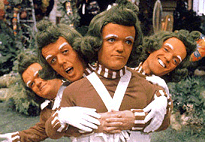 Plutonium Page Sebring from the University of New Mexico likes the idea of reverse polarity organic reactions, which go by the silly name of 'Umpolung reactions'. It sounds a bit like one of the songs sung by the Oompa–Loompas (photo right) in the original film 'Willy Wonka and the Chocolate factory'.
Plutonium Page Sebring from the University of New Mexico likes the idea of reverse polarity organic reactions, which go by the silly name of 'Umpolung reactions'. It sounds a bit like one of the songs sung by the Oompa–Loompas (photo right) in the original film 'Willy Wonka and the Chocolate factory'.
- Anthony Saglimbeni says that at Grad school, they used to call Sodium Methoxide by the nickname 'Naomi' (Na-OMe), so that you'd add a pinch of Naomi to a reaction and watch it go!
 Rob Towart found an article from the Canadian Medical Assoc. Journal 93 (1965) about a hypothetical new contraceptive drug shown left. The authors named it 'armpitin', since 'its effectiveness was most pronounced when applied to the female axillary regions.' Readers can quickly identify the mode of operation, being associated with the numerous NO groups in the molecule. In fact, the number of NO groups can be modified from one to infinity. The authos state that the contraceptive effect is directly proportional to the number of NO groups in the molecule, with each NO corresponding to one day's contraceptive effect.
Rob Towart found an article from the Canadian Medical Assoc. Journal 93 (1965) about a hypothetical new contraceptive drug shown left. The authors named it 'armpitin', since 'its effectiveness was most pronounced when applied to the female axillary regions.' Readers can quickly identify the mode of operation, being associated with the numerous NO groups in the molecule. In fact, the number of NO groups can be modified from one to infinity. The authos state that the contraceptive effect is directly proportional to the number of NO groups in the molecule, with each NO corresponding to one day's contraceptive effect.
- Joe Kosmoski told me the following: "Several years ago, I was lucky enough to sit in on a Seminar titled 'Dog CRAP'. Most Chemists know that CRAP stands for Crude Reagent and Products, and that iron (Fe) is know as the dog metal. Hence when conducting reactions with iron, one would expect to find plenty of Dog CRAP." And on a similar theme, John Lamper suggested that the chemical formula for dog's urine should be K9P, while David Govett said that its chemical name should be fidourine (Fido-Urine).
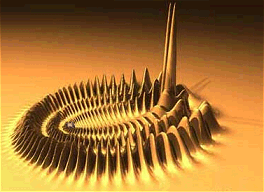 |
- Here's another chemical curiosity: researchers have recently predicted the existence of a giant two-atom rubidium molecule with an electron cloud resembling a trilobite, the ancient, hard-shelled creature which lived over 300 million years ago. The peaks in the figure (left) represent the probability of finding a valence Rb electron at different points in space. Although it has yet to be seen experimentally, the trilobite molecule would have many remarkable properties. For example, it would be huge for something consisting of just two atoms: calculations suggest that the cores of the Rb atoms would be separated from anywhere between 500-50,000 Å.
|
- Chemists have always had a problem with pronunciation...why should anion be pronounded an-ion, and not ay-neon (like onion)? And what about cation and dication, why pronounce them die-cat-ion, not dick-ayshun as it should be in normal English rules? And if there's no charge at all, it's unionised...now is that un-ionised or union-ised? [Thanks to Peter Rice and to Bob Bagnall for this last one].
- Bob Bagnall also told me of an article he once wrote in which he mused on the choice of the name Buckminsterfullerene for beautifully symmetrical ball-like moleules. He then offered the name Carbunclene or its saturated equivalent Carbunclane to describe molecules at the other end of the beauty scale - in other words the ugly misshapen or warty molecules of this world. He was following Prince Charles, of course, who described a particular modern London building as a 'carbuncle'. Sadly the name carbunclene hasn't caught on, but it remains as a suggestion for any synthetic chemists who make a particularly butt-ugly molecule and can't decide what to call it.
- Bob also told me that in another article he wrote for New Scientist he suggested that scientific prominence was inversely proportional to frequency of surname, and as proof he offered the fact that I knew of no Smith, Jones or Brown laws. And he'd never met an Avagadro in his entire life. He called it "Bagnall's Hypothesis" and drew flak from one or two Smiths who offered a mathematical puzzle called "Smith's Conjecture". He suggested that the best way to succeed in science if you have a common surname is to change it by deed-poll to something unusual. He even suggested a suitable name - noting that Newton (NEW TON) and Einstein (trans. ONE STONE) were units of mass, he suggested that some variation on GRAM might do the trick. How about Anna Gram?
- Jerry Van Cleeff emailed me to say that it was curious that the organic molecule named Fluorene (C13H10) doesn't contain the element Fluorine. He also said that he'd heard that "Scientists in Pisa, Italy, have discovered a possible reason why the Leaning Tower cannot be fixed - the soil around the tower contains the aromatic compound Azulene" Geddit?
- Dennis W. Gordon from Madison USA emailed me to suggest some molecules whose chemical formulas make amusing words. Does BO make you smell? Is BS as bad as it sounds? And there are the intermetallic compounds BaNa2 and WHoRe. He also asks the question: Is Nb N.B. in NB? (i.e. is niobium notable in New Bruswick?). Is the W.C. in your favorite pub made of WC? It might be necessary if they have a rough clientele... Formic acid is HOOCH, which is an alco-pop in the UK or slang for illicit liquor in the US.
- David Bradley has created a fun website called The Chymical Wedding all about how chemicals are used in life, weddings and marriage.
- and Thomas Jeanmaire gave me the link to the wonderful environmentally active web site to do with banning the dangerous chemical 'Dihydrogen Monoxide'.
- Bob Lidral told me about the fictitious molecule thiotimoline, which was invented by the Sci-Fi author Isaac Asimov as a joke. He wrote a spoof article describing experiments with thiotimoline, and said that was so soluble that it dissolved in water up to 1.3 seconds before the water was added! It's also interesting what happened after the article was piublished, as reported in this blog. A more recent spoof article describing the purported synthesis of this fictitious molecule can be found here in The Journal of Immaterial Science.
- Malin Dollinger, a cancer physician from LA, told me that there are two drugs that are used to to bring back patients who are hopelessly ill with cancer. These drugs are known by their nicknames in humorous exchanges among cancer physician colleages, as Resurectine and Lazarine.
- And on the subject of fictitious drug names, Charles Turner sent me the following:
"In Pharmacology all drugs have two names - a trade name and a generic name. For example, the trade name of Tylenol has a generic name of acetaminophen (or paracetamol in the UK). Aleve is also called naproxen. Amoxil is also called amoxicillin and Advil is also called ibuprofen.
The FDA has been looking for a generic name for Viagra. After careful consideration by a team of government experts, it recently announced that it has settled on the generic name of mycoxafloppin. Also considered were : mycoxafailin, mydixadrupin, mydixarizin, mydixadud, dixafix, and of course, ibepokin."
- David Vogel informed me that in his lab, they often say "Did you take your Dumacium today?" when someone does something stupid. He also thinks it would make an appropriate name for a placebo. On a similar theme, Lynton Cox told me that he once sent a know-it-all technician to look for some Tedium sulphate and Euphorium nitrate. And he's still waiting for someone to discover a super metal for musical instruments Didumdidumdium! He also says that chemists synthesise precipitates all the time but he's have never seen precipitic acid.
- Speaking of placebos, Paul Bohn from Mount Sterling, OH, USA sent me the following extract from a book called The Throwing Madonna: Essays on the Brain.
 "Placebos raise a problem in these days of the pharmacist labeling pill bottles with their contents. One cannot admit that the pill is nothing but sugar if it is to work, so a fancy brand name is needed. Among the proposals made in the scientist's humor magazine The Journal of Irreproducible Results for what to name a brand-name placebo are Confabulase, Gratifycin, Deludium, Hoaxacillin, Dammitol, Placebic Acid and Panacease." Apparently, 'obecalp' is also used as well.
"Placebos raise a problem in these days of the pharmacist labeling pill bottles with their contents. One cannot admit that the pill is nothing but sugar if it is to work, so a fancy brand name is needed. Among the proposals made in the scientist's humor magazine The Journal of Irreproducible Results for what to name a brand-name placebo are Confabulase, Gratifycin, Deludium, Hoaxacillin, Dammitol, Placebic Acid and Panacease." Apparently, 'obecalp' is also used as well.
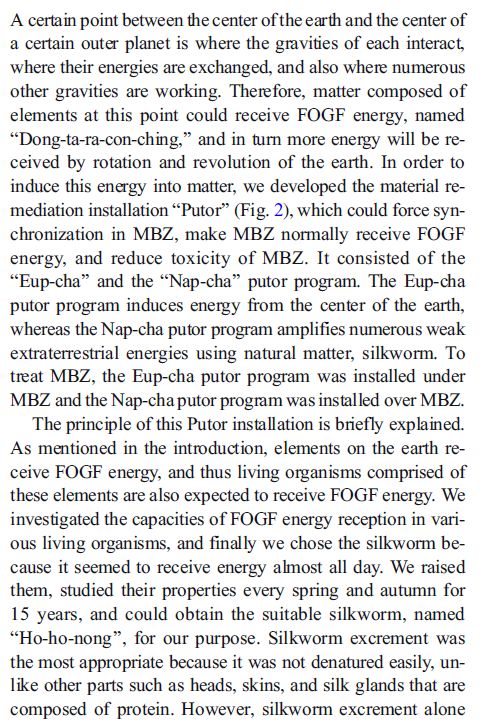 Charles Turner sent me this post on the website Symptoms of the Universe by a physicist named Philip Moriarty. It points out what may be the craziest paper ever accepted by a decent mainstream science journal. The whole paper can be seen here, but an extract from it is shown in the image on the right. As you can see it is utter gibberish (Dong-ta-ra-con-ching!), but it still got peer-reviewed and accepted by the Journal Parisitology Research. Only once readers started writing to the editor saying it was complete nonsense did the Journal bother to check, and finally retract the paper. But they never gave any explanation as to how this ridiculous paper got through their review process.
Charles Turner sent me this post on the website Symptoms of the Universe by a physicist named Philip Moriarty. It points out what may be the craziest paper ever accepted by a decent mainstream science journal. The whole paper can be seen here, but an extract from it is shown in the image on the right. As you can see it is utter gibberish (Dong-ta-ra-con-ching!), but it still got peer-reviewed and accepted by the Journal Parisitology Research. Only once readers started writing to the editor saying it was complete nonsense did the Journal bother to check, and finally retract the paper. But they never gave any explanation as to how this ridiculous paper got through their review process.
- Charles Turner also sent me a link to this unusual article which appeared in Chem. Comm. in 2019 by an Australian group headed by Peter May (no relation to myself!). The paper reports a study into the well-known S2-(aq.) ion which has been the mainstay of sulfide chemistry for decades and features in most Inorganic Chemistry textbooks. They searched for this ion using Raman spectroscopy, but couldn't find it. They concluded that this ion simply didn't exist, and all the textbooks are wrong. The abstract sums it up: "New Raman spectra of Na2S dissolved in hyper-concentrated NaOH(aq.) and CsOH(aq.) cast serious doubt on the widely-assumed existence of S2-(aq). To avoid conceptual and practical problems with sulfide equilibria in numerous applications, S2-(aq.) should be expunged from the chemical literature. Thermodynamic databases involving sulfide minerals also need careful revision." S2-(aq.) R.I.P.
- James Fieldsend sent me this chemistry one-liner, which would make a nice email quote: "If you're not part of the solution, you're part of the precipitate."
- And Andy told me about a conversation he'd had with a young chemistry pupil, who asked him what 'borax' was. Not wanting to be sidetracked at that precise moment he answered, "It's what a Japanese carpenter says when he hits his thumb with a hammer."
- And finally, a chemical joke sent in by Richard H McCaffrey:
Did you hear about the chemist who walked into a pub and asked for a pint of adenosine triphosphate?
The bartender said "Sure thing...that'll be ATP, please." (80p in English money, geddit?)
Crazy diagrams
- Can anyone spot the typo in this book title by Springer? (below, click to enlarge)
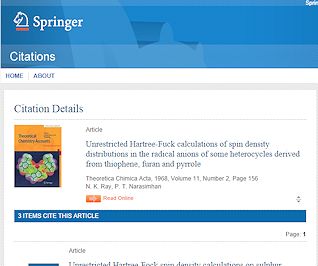
- Eric Kaufman from North Carolina State University sent me this reference to a ruthenium compound known short-hand as Ru(Tris)BiPy-on-a-stick (pronounced Rew-Tris-Bip-e on a stick). The picture from the paper must be one of the most suggestive molecular pictures in any Chemistry Journal. [Ref: S.H. Toma, et al, Inorg. Chem. 43 (2004) 3521.]

- On the same theme, Christian Thøgersen told me that the photo below comes from an actual Periodic Table, which features the applications of the various elements in its various states and forms. It looks like somebody put in the extra description of krypton for fun, and it went unnoticed until some undergraduate with a digital cam found it.
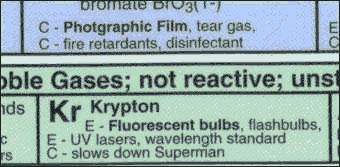
- Jason Masuda from University of California, Riverside, sent me the cartoon below which is taken from a textbook by M. Sclosser ["Modern Synthetic Methods" (R. Scheffold, ed.) VCH, 1992, 227-271]. There is a whole 'zoo' of superbases based on the original molecule called 'Schlosser Base', and each base behaves in different ways and has been given a nickname. The cartoon depicts the characteristics of each base, so n-BuLi/KOtBu (nicknamed 'LICKOR') is the 'workhorse' used for many general reactions, LIC works, but is slow like snail, while 'LICMEDA' is a bit of a lame duck. I'll leave you to guess how the others react based on their animal analogues...
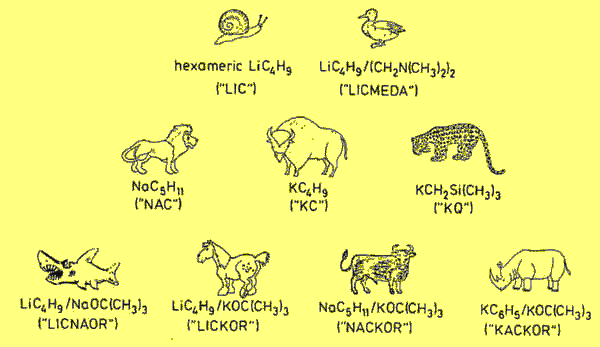
- And on a similar animal theme, M. Farooq emailed me with a copy of an article entitled "Old MacDonald Named a Compound: Branched Enynenynols" that was originally published in the J. Chem. Ed. 74 (1997) 782, about what would happen if 'Old MacDonald' were a chemist, and made molecules that have the shapes of animals. Some are shown below.
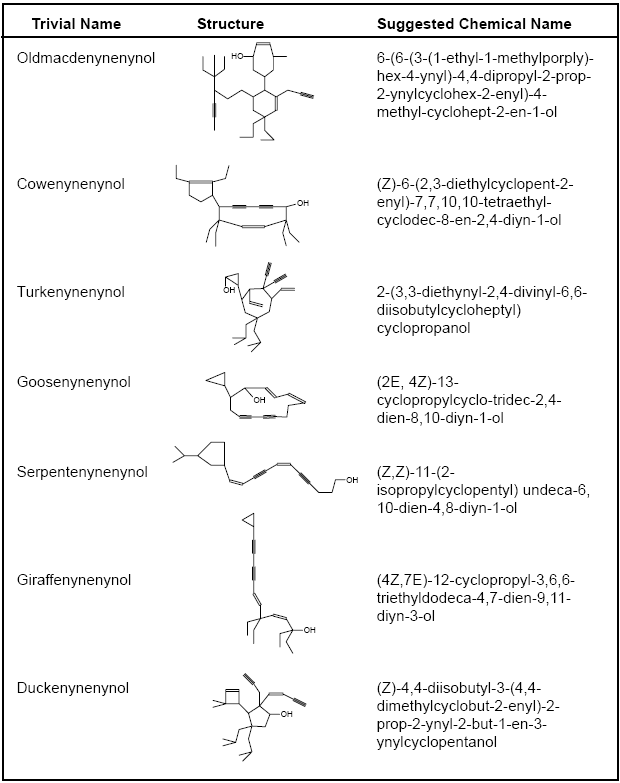
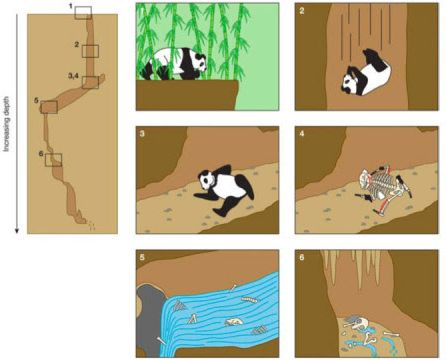
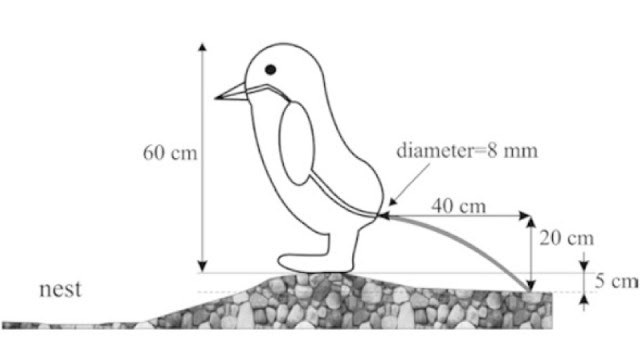
- Charles Turner sent me another contender for the silliest figure to appear in a respectable scientific Journal, shown on the right. This figure comes from an article entitled "The Nine Circles of Scientific Hell" — which that seeks to "take a humorous look at the fate that awaits scientists who sin against best practice," published in Perspectives on Psychological Science. This article has another claim to fame, in that its author is the first blogger ever to publish in a peer-reviewed academic journal under a blogging pseudonym - Neuroskeptic.
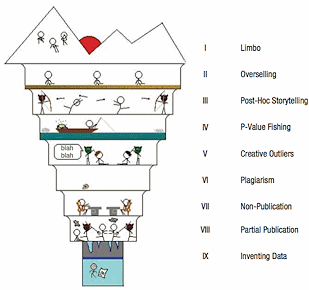
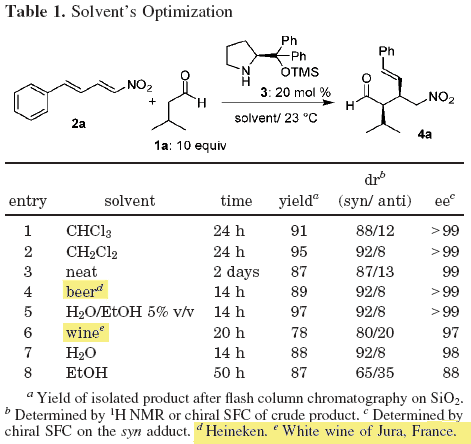 A recent paper [S. Belot, A. Massaro, A. Tenti, A. Mordini, A. Alexakison, Org. Lett. (2008)] about enantioselective reactions showed that water/alcohol mixtures were excellent solvents for these reactions...so they tried a lot of different variants of these, including beer and wine! The table showing their 'solvent optimisation' is shown on the right.
A recent paper [S. Belot, A. Massaro, A. Tenti, A. Mordini, A. Alexakison, Org. Lett. (2008)] about enantioselective reactions showed that water/alcohol mixtures were excellent solvents for these reactions...so they tried a lot of different variants of these, including beer and wine! The table showing their 'solvent optimisation' is shown on the right.
- Another scientific 'Easter Egg' appeared in the Dec 2018 issue of Scientific Reports [K.L. Chiou et al, Sci. Rep., 8, 1975 (2018)], where an image of a baboon turd had Donald Trump's face superimposed onto it. The Journal investigated, and made the authors alter the figure removing the face. The face was quite tricky to see in the original figure because the baboon turd was so small (see below), but in the enlarged version, the face of Trump is clearly visible. The statement by the Journal is also shown...
which makes no mention as to what the 'unusual aspects' of the figure were.

-
Charles Turner sent me a copy of the cover of the Biophysical Journal for March 2013 which is one of the weirdest covers of a scientific journal I've seen. It depicts a cartoon of Myosin-V walking like “Mr. Natural” as it tilts and wobbles to complete its step. This Dr Seuss-esque cover was inspired by the cover for the record album, “Truckin’ My Blues Away”, drawn by the cartoonist Robert Crumb.
|
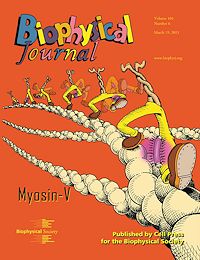 |
-

Penguin diagram superimposed on a real penguin.
[Image: Quilbert / CC BY-SA (from Wikimedia Commons) |
Charles Turner also told me the story about particle physicist, John Ellis, who lost a bet in a darts match with fellow physicists which stated that he had to include the word "penguin" in his next scientific paper. After struggling to find a way, he "smoked some illegal substances" which gave him the inspiration. He was working on particle decays, which use the famous Feynman diagrams to illustrate how one partice decays into another with the release of energy. The types of particle he was studying decayed via a new and interesting route, which could be visualised by drawing the Feynman diagram in a specific way. He noticed these diagrams looked like penguins, so the 'Penguin Diagram' was born and the bet forfeit was completed.
|
- Most chemists are familiar with Pyrex, the heat-resistant glassware used in synthetic chemistry. But how did get its name? According to William B. Jensen, the story goes:
"At least three rationales have been suggested for the origin of the name Pyrex. Reflecting its initial use for cookware, including pie pans, it could be either an English–Latin (py = pie + rex = king) hybrid for “pie king” or a Greek–Latin hybrid (pyr = fire + rex) for “fire king”, or a contraction for its most important physical property: low thermal (pyr) expansion (ex). As it turns out, none of these are correct, though the first version is closer to the truth than the others. Reflecting its use for glass pie pans, it was originally called “Pie Rite” or “Py-Right”, but the name was eventually changed to Pyrex in order to rhyme with “Nonex”, an earlier brand of borosilicate glass marketed by Corning for use in railroad signal lamps."
Ref: William B. Jensen, The Origin of Pyrex, J. Chem. Ed. 83, (2006) 692. Thanks to Jan Linders for sending me this article.
-
Another image sent to me by Charles Turner is of the Periodic Table
as reimagined by Lady Gaga: |
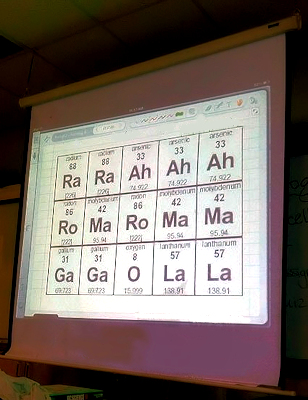 |
Chemical stories
This wonderful chemical story appeared in J. Chem. Educ. July 1960, p354
The Case of the Missing Joules
Inspector Sherlock Ohms, of Standard International Yard, was driving across the Wheetstone Bridge in his '09 Maxwell. He was trying to remember Ava Gadro's number so he could call and data for the Policeman's Ball-when suddenly he blew a tire.
"OH- Nernst" said Sherlock, "I don't have a tire ion with me, but luckily ammonia short distance from the Ideal Gas Station."
(This business was handled by Saul Vent, who, at the moment, was freon bail).
Just as the inspector emerged from the station, a rubber policeman whizzed by on his Carnot cycle. Ohms knew he was deuteride by, but he wondered watt made him rush so. He shouted atom, but he was gone. Ohms' reaction was instantaneous. By radio activity he learned that Micro Farad, Recipro City's top-ranking rookie, was chasing a joule thief.
Ohms chased Micro down Elect Road, around the Elastic Modulus, back over Salt Bridge and up into Farren Heights. He turned left at the Old Ball Mill, went past the Mono Clinic, the Palladium, and all the way to the liquid junction at Endothermic Street. They were almost across the city line when Sherlock's car swerved and crashed into a Van der Waal. The impact splintered the Plancks and punched a big hole in the hydrolysis system.
"I node that was going to happen," said Sherlock, "but I'd beta catch up to him."
Quickly he volted out of his rectilinear and took up the chase on foot. He soon came across Micro, standing in a magnetic field, holding Ann Hydrate and Al Doll at bay.
"Watt's the meaning of this?" queried the Inspector, and the copper was quick to explain.
"Well, Sir, I stopped in at the Invar Bar, a local dyne and dance spot, for a couple of quartz of Lambert Beer when I noticed Ann Hydrate sitting alone at a two-place log table. I knew some joule thieves had made a radon Ethyl Benzene's country estate, and I spotted one of the Benzene rings on her, along with a para Ethyl's earrings.
"Anode an explanation of this, but before I could torque to her, she was in her coat of rust and out the door. Being true to the Kopp's Rule, I was quick to follow; but when she got into her Monochromatic-8, I knew I was infra tough chase. Fortunately her engine started Fehling just beyond the city limits and I caught her."
"She had led me to the missing joules, and also to her accomplice, Al Doll, who was about to barium in a hollow common log, under the square roots of this deserted magnetic field. While we were waiting for you, their other partner, Cal Orie, tried to run me down with his Mercury. Did that make my blood Boyle! I dodged and hit him with a bag of Boltz . . . man! Did that change his molar concentration!"
"But really, Inspector, there wasn't any trig in catching these joule thieves. I just Van't Hoff on a normal lead - don't you zinc that explains it?"
Inspector Ohms beamed. "Son, you'll go on nights for this!"
(In effect, this was a promotion - for in Recipro City, nitrates are much mohr than those faraday man.)
anon
- Charles Turner found this article about a newly discovered element:
New Element discovered
A major research institution recently announced the discovery of the heaviest element yet known to science. This new element tentatively has been named "Corporatium." Corporatium has 1 neutron, 12 assistant neutrons, 75 deputy neutrons, and 111 assistant deputy neutrons, giving it an atomic mass of 312.
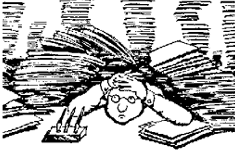 These 312 particles are held together by a force called morons, which are surrounded by vast quantities of lepton-like particles called peons. Since Corporatium has no electrons, it is inert. However, it can be detected as it impedes every reaction with which it comes into contact.
These 312 particles are held together by a force called morons, which are surrounded by vast quantities of lepton-like particles called peons. Since Corporatium has no electrons, it is inert. However, it can be detected as it impedes every reaction with which it comes into contact.
A minute amount of Corporatium causes one reaction to take over 4 days to complete when it would normally take less than a second. Corporatium has a normal half-life of 3 years; it does not decay but instead undergoes a reorganization, in which a portion of the assistant neutrons and deputy neutrons and assistant deputy neutrons exchange places.
In fact, Corporatium's mass will actually increase over time, since each reorganization causes some morons to become neutrons forming isodopes. This characteristic of moron-promotion leads some scientists to speculate that Corporatium is formed whenever morons reach a certain quantity in concentration. This hypothetical quantity is referred to as "Critical Morass."
You will know it when you see it...
[There's another version of this, where the densest element is called "Bushcronium", with symbol "Du" for "Dubya". The rest of the article is the same, but then the following is added at the end]:
When catalyzed with money, Bushcronium activates Foxnewsium (Fx), an element that radiates orders of magnitude more energy, albeit as incoherent noise, since it has 1/2 as many peons but twice as many morons.
The "nucular" reaction alluded to below, where Du combines with Foxnewsium when bombarded by a moron beam yields:
Du + m (morons) + Fx = DumFx
which is sometimes phonetically pronounced to describe the nature of the isodope produced.
Chemical songs, poems and limericks
- Probably the most famous chemistry song is 'The Elements' by Tom Lehrer in which he recites the name of every chemical element to the tune of Gilbert and Sullivan's 'Modern Major General'. There's also a version of this song (The Drugs Song) by Drs Suman Biswas and Adam Kay, but reciting the names of common chemicals and medical drugs. These guys have also written a song about the ultimate medical drug: Paracetamoxyfrusebendroneomycin
- David Bradley emailed me to point out a collection of popular songs whose lyrics have been altered to turn them into chemistry songs.
- And Anthony Shireman told me that his Biochemistry professor sings some crazy songs that are biochemistry related at the end of every term.
- Here's a little limerick, sent in by Gregory Bond.
"A mosquito was heard to complain
that a chemist had poisoned his brain.
The cause of his sorrow
was paradichloro-
Diphenyltrichloroethane!
- And another little ditty, sent in by Garry Heather from Sony.
"Ernie was a chemist,
now Ernie is no more.
For what he thought was H2O,
was H2SO4."
- Here's a ditty that was taught to Jerry Goodenough by his Chemistry teacher.
Poor Jimmy, finding life a bore,
Drank some H2SO4.
Jimmy's father, an MD,
Gave him CaCO3.
Now he's neutralised, it's true,
But he's full of CO2. [The last line to be interrupted by a burping sound!]
- Here's a limerick sent to me by Ian Livingstone.
There was a young chemist from Ryde,
Who drank a foul poison and died.
It was ortho-hydroxy-
para-methoxy-
tri-nitro benzaldehyde!
- And here's another celebrating Paul Ehrlich's anti-syphillis drug Salvarsan.
A chemist named Ehrlich, unclean,
Engaged in researches obscene.
He injected the poxy
with bis(para-hydroxy
meta-amino arseno-benzene).
- And here's a Chemist's prayer originally published by David Cornforth in 1962 or 63 in the Proc. Chem. Soc.
O Lord, I kneel upon my knees
and pray that all my syntheses
may no longer be inferior
to those conducted by bacteria.
- Sam Long from Springfield, Illinois, sent me a few chemical songs he composed while studying Chemistry at the University of North Carolina (Chapel Hill). The first one is to the tune of 'Maria' from West Side Story.
Urea, I just made a compound, Urea!
C-O-N-H-2-2, it makes me kind of blue to see
Urea, I'll never stop making Urea,
For suddenly I've found
How wonderful compounds can be!
Urea! Say it loud and there's music playing.
Say it soft, and it smells like decaying.
Urea, I'll never stop making Urea!
The most beautiful compound I ever made...
Urea, Urea!
And here's another, to the tune of 'Waltzing Matilda'.
Once a jolly beaker camped by a washing sink
Under the hood in a lab'ratory,
And he sang as he washed and waited till his acid boiled,
"You'll come a-washin' me test tube with me!"
"Washin' me test tube, washin' me test tube,
You'll come a-washin' me test tube with me!"
And he sang as he washed and waited till his acid boiled,
"You'll come a-washin' me test tube with me!"
And here's another, to the tune of the country-&-western song from 1963, "Abilene", made famous by George Hamilton IV:
Alanine, Alanine,
Prettiest compound I've ever seen.
It's both an acid and an amine,
O Alanine, my Alanine.

Links
- Of course, there are always some fictitious "Molecules you should be aware of": I, II and III from the Lab Initio cartoon page.
- ...as well as a large collection of Peculiar Scientific Names from the biological world by Doug Yanega from the University of California.
- and another load of peculiar and funny biological names can be found at Mark Isaac's Curiosities of Biological Nomenclature page.
- Another fun page is Named things in Chemistry and Physics, based at York University in Toronto, Canada, which contains lots of info and anecdotes about famous scientists, named reactions, etc.
- and Lloyd Evans has a collection of odd and double-entendre terms in Chemistry.
- A detailed source of weird and wonderful names, especially in organic chemistry can be found in "Organic Chemistry - the Name Game", by Alex Nickon and Ernest F. Silversmith (Pergammon, New York, 1987).
- A list of factual information and spurious anecdotes about famous scientists can be found at: http://www.famous-scientists.net
- And you may like to look at The Journal of Unpublished Chemistry which is "an international journal for the communication of chemistry which is inappropriate for submission to any other publication".
- ...and related to that, are the Ig Nobel Prizes which "are intended to celebrate the unusual, honor the imaginative - and spur people's interest in science, medicine, and technology".
- On a similar theme, there's the magazine Null Hypothesis, which bills itself as the Journal of Unlikely Science.
- The Abbreviations of Chemical Compounds can also give hours of fun for all the family...
- ...and there is a list of humour from school teachers at: http://www.teacherhumor.com
- and a list of Urban Legends relating to college subjects, and another nice page about silly things written by students in chemistry exams.
- Have you ever wanted to make molecules out of balloons? Find out how!.

This site has been featured in:

Member of the Science Humor Net Ring
[
Previous 5 Sites
|
Previous
|
Next
|
Next 5 Sites
]
[
Random Site
|
List Sites
]
![]()

![]()



 Lars Finsen tells me that the octafluoroxenates with the anion XeF82- are the most stable noble gas compounds known. But if any analogous krypton compounds were ever made, they would probably be called fluorokryptonates in the higher oxydation stages and fluorokryptonites in the lower oxidation stages, in accordance with traditional nomenclature - for instance, sodium tetrafluorokryptonite, Na2KrF4. He says that this might possibly be a useful substance to have around if you were planning to rob a bank in Metropolis? Tue Bruun Petersen, however, thinks that the name kryptonite would have been given to the anion KrO22- before IUPAC nomenclature was enforced.
Lars Finsen tells me that the octafluoroxenates with the anion XeF82- are the most stable noble gas compounds known. But if any analogous krypton compounds were ever made, they would probably be called fluorokryptonates in the higher oxydation stages and fluorokryptonites in the lower oxidation stages, in accordance with traditional nomenclature - for instance, sodium tetrafluorokryptonite, Na2KrF4. He says that this might possibly be a useful substance to have around if you were planning to rob a bank in Metropolis? Tue Bruun Petersen, however, thinks that the name kryptonite would have been given to the anion KrO22- before IUPAC nomenclature was enforced. John Wolstenholme emailed me to say that he remembered a Professor at Oxford who once synthesised a Mo compound containing some olefinic and amine ligands, and (unsuccessfully) tried to get it named 'ene amine amyne a Mo'. And similarly, Matt Jandreau told me that one of his professors mentioned a new molecule (structure, right) in organic chemistry. He said "Old McDonald made this molecule... ene-yne-ene-yne-one".
John Wolstenholme emailed me to say that he remembered a Professor at Oxford who once synthesised a Mo compound containing some olefinic and amine ligands, and (unsuccessfully) tried to get it named 'ene amine amyne a Mo'. And similarly, Matt Jandreau told me that one of his professors mentioned a new molecule (structure, right) in organic chemistry. He said "Old McDonald made this molecule... ene-yne-ene-yne-one". HI-O Silver is a wonderful inorganic compound suggested by Michael Klemmer, although it doesn't actually exist. If it did, it would surely be the Lone Ranger's favourite molecule. For those of you who don't remember this classic TV series, the Lone Ranger rode a horse called Silver, and his catch phrase was "Hi-O-Silver...away!" I haven't yet found a molecule called Tonto, though... This originally appeared as graffiti on a bathroom stall in the Chemistry building at the University of Minnesota as the reaction:
HI-O Silver is a wonderful inorganic compound suggested by Michael Klemmer, although it doesn't actually exist. If it did, it would surely be the Lone Ranger's favourite molecule. For those of you who don't remember this classic TV series, the Lone Ranger rode a horse called Silver, and his catch phrase was "Hi-O-Silver...away!" I haven't yet found a molecule called Tonto, though... This originally appeared as graffiti on a bathroom stall in the Chemistry building at the University of Minnesota as the reaction:![]() HIO + Ag [Up arrow] (Away!)
HIO + Ag [Up arrow] (Away!) Bert Ramsay tells me that he developed a hypothetic molecule called E-cubane, named after the artist MC Escher, who was renown for his 3D pictures of 'impossible' structures and buildings'. E-cubane is an 'impossible' version of cubane, as you can see from the image right.
Bert Ramsay tells me that he developed a hypothetic molecule called E-cubane, named after the artist MC Escher, who was renown for his 3D pictures of 'impossible' structures and buildings'. E-cubane is an 'impossible' version of cubane, as you can see from the image right. Fakein is the name given to a fictitious molecule dreamt up by Angelo Gavezzotti from the University of Milan. He devised a new molecule based on a structure similar to that of taxol, and then used standard off-the-shelf free software and a simple laptop to predict all the structural, thermodynamic and crystallographic properties of the imaginary molecule. He even devised plausible experimental routes to extract the molecule from a nautural source, the imaginary bush Artemisia fictitia that grows spontaneously in the tropical region of the State of Erewhon. Erewhon (an anagram of Nowhere) is the name of the non-existent country in the 1872 satirical novel of the same name by Samuel Butler. Gavezzotti gave fakin a catalogue number of M31NGC224, which mimics the labels usually given to pharmaceutical leads, but is actually the catalog number of the Andromeda Galaxy. And fakein was said to be in the development pipeline at the NEMOpharma Company, another figment of the author’s imagination! The reason for all this subterfuge was to demonstrate how easy it is nowadays to realistically fake the extraction and characterisation of a 'new' molecule. The characterisation, data, spectra and properties of the fake molecule are so realistic and believeable that they could pass peer review in many Journals. The title of the paper 'Crystallography without Crystals' is really a warning about the future of scientific credibility now that molecular 'deep fakes' are possible.
Fakein is the name given to a fictitious molecule dreamt up by Angelo Gavezzotti from the University of Milan. He devised a new molecule based on a structure similar to that of taxol, and then used standard off-the-shelf free software and a simple laptop to predict all the structural, thermodynamic and crystallographic properties of the imaginary molecule. He even devised plausible experimental routes to extract the molecule from a nautural source, the imaginary bush Artemisia fictitia that grows spontaneously in the tropical region of the State of Erewhon. Erewhon (an anagram of Nowhere) is the name of the non-existent country in the 1872 satirical novel of the same name by Samuel Butler. Gavezzotti gave fakin a catalogue number of M31NGC224, which mimics the labels usually given to pharmaceutical leads, but is actually the catalog number of the Andromeda Galaxy. And fakein was said to be in the development pipeline at the NEMOpharma Company, another figment of the author’s imagination! The reason for all this subterfuge was to demonstrate how easy it is nowadays to realistically fake the extraction and characterisation of a 'new' molecule. The characterisation, data, spectra and properties of the fake molecule are so realistic and believeable that they could pass peer review in many Journals. The title of the paper 'Crystallography without Crystals' is really a warning about the future of scientific credibility now that molecular 'deep fakes' are possible.



 And Charles Turner pointed me to an article about F.D.C. Willard, who was the co-author of a number of scientific papers in the 1970s. It turns out that Willard is actually a cat. The story goes that Professor Jack H. Hetherington, asked a colleague at Michigan State University to read over a paper he’d written on the subject of low temperature physics and planned for submission to Physical Review Letters. After reading over the paper, the colleague told Hetherington that he had often referred to himself using the words “we” and “our”. Normally this isn't a problem for most Journals. But PRL had a rule that stated papers with a singular author shouldn’t use the first person plural. Being the 1970s, Hetherington had typed up the entire paper using a typewriter, so fixing this mistake would have involved retyping the entire manuscript. Instead, he simply invented a co-author, his cat, Chester. To give the cat a little more credibility, Hetherington stylised Chester’s name as “Felis Domesticus Chester, sired by Willard” which was shortened to “F.D.C. Willard”. The paper was published successfully later that year.
And Charles Turner pointed me to an article about F.D.C. Willard, who was the co-author of a number of scientific papers in the 1970s. It turns out that Willard is actually a cat. The story goes that Professor Jack H. Hetherington, asked a colleague at Michigan State University to read over a paper he’d written on the subject of low temperature physics and planned for submission to Physical Review Letters. After reading over the paper, the colleague told Hetherington that he had often referred to himself using the words “we” and “our”. Normally this isn't a problem for most Journals. But PRL had a rule that stated papers with a singular author shouldn’t use the first person plural. Being the 1970s, Hetherington had typed up the entire paper using a typewriter, so fixing this mistake would have involved retyping the entire manuscript. Instead, he simply invented a co-author, his cat, Chester. To give the cat a little more credibility, Hetherington stylised Chester’s name as “Felis Domesticus Chester, sired by Willard” which was shortened to “F.D.C. Willard”. The paper was published successfully later that year. Charles Turner told me of a biological paper which has managed to get the phrase 'Shit happens' into the title of a respected scientific Journal! The paper concerns the various creatures (dung beetles, amphibians, etc) that can live in elephant droppings, and is actually entitled: "Shit Happens (to be Useful)! Use of Elephant Dung as Habitat by Amphibians", A. Campos-Arceiz, Biotropica 41 (2009) 406.
Charles Turner told me of a biological paper which has managed to get the phrase 'Shit happens' into the title of a respected scientific Journal! The paper concerns the various creatures (dung beetles, amphibians, etc) that can live in elephant droppings, and is actually entitled: "Shit Happens (to be Useful)! Use of Elephant Dung as Habitat by Amphibians", A. Campos-Arceiz, Biotropica 41 (2009) 406. And yet more on the same theme, there are a number of papers in journals by authors named Yin and Yang. A chemistry related one is: Yin C. and Yang C.Z. J. Appl. Polymer Sci, 82 (2001) 263.
And yet more on the same theme, there are a number of papers in journals by authors named Yin and Yang. A chemistry related one is: Yin C. and Yang C.Z. J. Appl. Polymer Sci, 82 (2001) 263.
 There's a paper in Chem. Rev. with the title The Hitchhiker's Guide to Flow Chemistry, with a superb graphical abstract with the words 'DON'T PANIC' written on it in large red comforting letters.
There's a paper in Chem. Rev. with the title The Hitchhiker's Guide to Flow Chemistry, with a superb graphical abstract with the words 'DON'T PANIC' written on it in large red comforting letters.



 Joerg Heim emailed me to say that a very well known German Drosophila geneticist (name omitted for discretion) told him once that he prefers to name the most ugly/lethal mutants after lab-personnel, and the nice ones after his wife (and several nicknames). Charles Turner also found a whole load of genes that have been given silly names, including:
Joerg Heim emailed me to say that a very well known German Drosophila geneticist (name omitted for discretion) told him once that he prefers to name the most ugly/lethal mutants after lab-personnel, and the nice ones after his wife (and several nicknames). Charles Turner also found a whole load of genes that have been given silly names, including: Jan Linders told me about a newly discovered protein in fruit fly embryos that destroys maternal proteins that was published recently [eLife (2020) 9, e53889]. This gene removes unnecessary molecules, keeping embryos organized, and free of clutter. So they named it Marie Kondo (photo, right) after the well-known TV presenter who is famous for tidying up, and who hosted the 2019 Netflix series Tidying Up with Marie Kondo.
Jan Linders told me about a newly discovered protein in fruit fly embryos that destroys maternal proteins that was published recently [eLife (2020) 9, e53889]. This gene removes unnecessary molecules, keeping embryos organized, and free of clutter. So they named it Marie Kondo (photo, right) after the well-known TV presenter who is famous for tidying up, and who hosted the 2019 Netflix series Tidying Up with Marie Kondo. And similarly, Darren Sydenham told me that in Australia the government tertiary education classes were nicknamed 'tech' by the students. In Geology lessons, when asking their lab supervisor about the mineral Tectonite, the students would ask 'Do we have tectonite?'. If the answer was no, they'd all go home!
And similarly, Darren Sydenham told me that in Australia the government tertiary education classes were nicknamed 'tech' by the students. In Geology lessons, when asking their lab supervisor about the mineral Tectonite, the students would ask 'Do we have tectonite?'. If the answer was no, they'd all go home! For those of you wishing to wear your favourite molecule as an item of jewelery, the website 'The Molecule Store' is the place to go. Here you can buy necklaces, bracelets, cufflinks and pendants (see photo, right) made fom silver and gold, shaped into the structures of molecules such as capsaicin (chilli), theobromine (chocolate), caffeine, etc. Other companies, such as Dopamine Jewelry, sell pieces made from microscopic photos of "behavior-altering chemicals" like acetylcholine and Chablis, while The DNA Store offers gold double-helix earrings and an enamel X chromosome pin, and DNA Stuff features double-helix bracelets and gold helix tie-tacks. [Thanks to Jan Linders for these links].
For those of you wishing to wear your favourite molecule as an item of jewelery, the website 'The Molecule Store' is the place to go. Here you can buy necklaces, bracelets, cufflinks and pendants (see photo, right) made fom silver and gold, shaped into the structures of molecules such as capsaicin (chilli), theobromine (chocolate), caffeine, etc. Other companies, such as Dopamine Jewelry, sell pieces made from microscopic photos of "behavior-altering chemicals" like acetylcholine and Chablis, while The DNA Store offers gold double-helix earrings and an enamel X chromosome pin, and DNA Stuff features double-helix bracelets and gold helix tie-tacks. [Thanks to Jan Linders for these links]. Leon Mathiasen from the University of Aarhus, Denmark, tells me that a famous organic reaction is called the Smiles Rearrangment (right), and organic chemists use it to cheer themselves up after a hard day in the lab.
Leon Mathiasen from the University of Aarhus, Denmark, tells me that a famous organic reaction is called the Smiles Rearrangment (right), and organic chemists use it to cheer themselves up after a hard day in the lab. Charles Turner pointed out that Gerti Cori received the Nobel Prize for her work on carbohydrate metabolism and became the third woman and first American woman to do so. In 2008, the US Post Office recognized her (along with Edwin Hubble, Linus Pauling, and John Bardeen) on a postage stamp, showing her portrait and a molecule, the Cori ester, she discovered. They decided to go ahead and issue the stamp despite the fact that there is an error in the chemical formula for the molecule. In case you haven't spotted it, the error is that the bond to the phosphate group should go to the first O, not the second.
Charles Turner pointed out that Gerti Cori received the Nobel Prize for her work on carbohydrate metabolism and became the third woman and first American woman to do so. In 2008, the US Post Office recognized her (along with Edwin Hubble, Linus Pauling, and John Bardeen) on a postage stamp, showing her portrait and a molecule, the Cori ester, she discovered. They decided to go ahead and issue the stamp despite the fact that there is an error in the chemical formula for the molecule. In case you haven't spotted it, the error is that the bond to the phosphate group should go to the first O, not the second. He also sent me the best ever Chemistry exam answer, shown in the image on the right.
He also sent me the best ever Chemistry exam answer, shown in the image on the right. Eddie Luzik also emailed me to say that in the 1998-9 edition of the Aldrich chemical catalogue there was a strange set of index headers on some pages. These index headers just contain a shortened version of the first chemical name on that page, for ease of searching. On pages 1579, 1580 and 1581 there is tetraKISME, tetraKISSU and then tetrALONE. Maybe this has some deeper meaning for the state of chemists' dating skills... (The full names of the molecules are: [1,2,3,4-Tetrakis(methoxy-carbonyl)-1,3-butadiene-1,4-dyl]palladium, 5,10,15,20-Tetrakis(4-sulfonatophenyl)-21H,23H-porphine manganese(III), and Tetralone. Unfortunately, in the new edition of the catalogue these molecules appear lower down the pages, so they no longer appear in the headers...).
Eddie Luzik also emailed me to say that in the 1998-9 edition of the Aldrich chemical catalogue there was a strange set of index headers on some pages. These index headers just contain a shortened version of the first chemical name on that page, for ease of searching. On pages 1579, 1580 and 1581 there is tetraKISME, tetraKISSU and then tetrALONE. Maybe this has some deeper meaning for the state of chemists' dating skills... (The full names of the molecules are: [1,2,3,4-Tetrakis(methoxy-carbonyl)-1,3-butadiene-1,4-dyl]palladium, 5,10,15,20-Tetrakis(4-sulfonatophenyl)-21H,23H-porphine manganese(III), and Tetralone. Unfortunately, in the new edition of the catalogue these molecules appear lower down the pages, so they no longer appear in the headers...). Plutonium Page Sebring from the University of New Mexico likes the idea of reverse polarity organic reactions, which go by the silly name of 'Umpolung reactions'. It sounds a bit like one of the songs sung by the Oompa–Loompas (photo right) in the original film 'Willy Wonka and the Chocolate factory'.
Plutonium Page Sebring from the University of New Mexico likes the idea of reverse polarity organic reactions, which go by the silly name of 'Umpolung reactions'. It sounds a bit like one of the songs sung by the Oompa–Loompas (photo right) in the original film 'Willy Wonka and the Chocolate factory'. Rob Towart found an article from the Canadian Medical Assoc. Journal 93 (1965) about a hypothetical new contraceptive drug shown left. The authors named it 'armpitin', since 'its effectiveness was most pronounced when applied to the female axillary regions.' Readers can quickly identify the mode of operation, being associated with the numerous NO groups in the molecule. In fact, the number of NO groups can be modified from one to infinity. The authos state that the contraceptive effect is directly proportional to the number of NO groups in the molecule, with each NO corresponding to one day's contraceptive effect.
Rob Towart found an article from the Canadian Medical Assoc. Journal 93 (1965) about a hypothetical new contraceptive drug shown left. The authors named it 'armpitin', since 'its effectiveness was most pronounced when applied to the female axillary regions.' Readers can quickly identify the mode of operation, being associated with the numerous NO groups in the molecule. In fact, the number of NO groups can be modified from one to infinity. The authos state that the contraceptive effect is directly proportional to the number of NO groups in the molecule, with each NO corresponding to one day's contraceptive effect. "Placebos raise a problem in these days of the pharmacist labeling pill bottles with their contents. One cannot admit that the pill is nothing but sugar if it is to work, so a fancy brand name is needed. Among the proposals made in the scientist's humor magazine The Journal of Irreproducible Results for what to name a brand-name placebo are Confabulase, Gratifycin, Deludium, Hoaxacillin, Dammitol, Placebic Acid and Panacease." Apparently, 'obecalp' is also used as well.
"Placebos raise a problem in these days of the pharmacist labeling pill bottles with their contents. One cannot admit that the pill is nothing but sugar if it is to work, so a fancy brand name is needed. Among the proposals made in the scientist's humor magazine The Journal of Irreproducible Results for what to name a brand-name placebo are Confabulase, Gratifycin, Deludium, Hoaxacillin, Dammitol, Placebic Acid and Panacease." Apparently, 'obecalp' is also used as well. Charles Turner sent me this post on the website Symptoms of the Universe by a physicist named Philip Moriarty. It points out what may be the craziest paper ever accepted by a decent mainstream science journal. The whole paper can be seen here, but an extract from it is shown in the image on the right. As you can see it is utter gibberish (Dong-ta-ra-con-ching!), but it still got peer-reviewed and accepted by the Journal Parisitology Research. Only once readers started writing to the editor saying it was complete nonsense did the Journal bother to check, and finally retract the paper. But they never gave any explanation as to how this ridiculous paper got through their review process.
Charles Turner sent me this post on the website Symptoms of the Universe by a physicist named Philip Moriarty. It points out what may be the craziest paper ever accepted by a decent mainstream science journal. The whole paper can be seen here, but an extract from it is shown in the image on the right. As you can see it is utter gibberish (Dong-ta-ra-con-ching!), but it still got peer-reviewed and accepted by the Journal Parisitology Research. Only once readers started writing to the editor saying it was complete nonsense did the Journal bother to check, and finally retract the paper. But they never gave any explanation as to how this ridiculous paper got through their review process.





 A recent paper [S. Belot, A. Massaro, A. Tenti, A. Mordini, A. Alexakison, Org. Lett. (2008)] about enantioselective reactions showed that water/alcohol mixtures were excellent solvents for these reactions...so they tried a lot of different variants of these, including beer and wine! The table showing their 'solvent optimisation' is shown on the right.
A recent paper [S. Belot, A. Massaro, A. Tenti, A. Mordini, A. Alexakison, Org. Lett. (2008)] about enantioselective reactions showed that water/alcohol mixtures were excellent solvents for these reactions...so they tried a lot of different variants of these, including beer and wine! The table showing their 'solvent optimisation' is shown on the right.



 These 312 particles are held together by a force called morons, which are surrounded by vast quantities of lepton-like particles called peons. Since Corporatium has no electrons, it is inert. However, it can be detected as it impedes every reaction with which it comes into contact.
These 312 particles are held together by a force called morons, which are surrounded by vast quantities of lepton-like particles called peons. Since Corporatium has no electrons, it is inert. However, it can be detected as it impedes every reaction with which it comes into contact.![]()
![]()
 Wikipedia has a section about silly molecules.
Wikipedia has a section about silly molecules. Scientific American magazine Sci/Tech award winner for 2002
Scientific American magazine Sci/Tech award winner for 2002
 UserFriendly.org (July 2001)
UserFriendly.org (July 2001) Backwash.com approved (2001).
Backwash.com approved (2001). Seven Wonders, September 22, 2003.
Seven Wonders, September 22, 2003. FatCat featured website - 5th July 2004.
FatCat featured website - 5th July 2004.![]()